An Automatic Method to Reduce Baseline Wander and Motion Artifacts on Ambulatory Electrocardiogram Signals
Abstract
:1. Introduction
2. Materials and Methods
2.1. Related Work
2.1.1. Digital Filters
2.1.2. Discrete Wavelet Transform
2.1.3. Empirical Mode Decomposition
2.1.4. Variational Mode Decomposition
2.1.5. Adaptive Filter
2.2. Proposed Algorithm
2.2.1. Data Acquisition
2.2.2. ECG Signal Preprocessing
- The process first inserts p (for example, ) zeros to up-sample the signal.
- Then the new signal is filtered by an FIR anti-aliasing filter to match the shape of the original signal. In this part, the Kaiser window method was used to approximate the ideal anti-aliasing filter.
- Finally, q (for example, ) samples in the up-sampled signal are discarded to obtain the final signal.
2.2.3. Detection of Unusable Signal with Support Vector Machine (SVM)
- TP: Number of correctly detected usable signals,
- FP: Number of incorrectly detected unusable signals,
- TN: Number of correctly detected usable signals,
- FN: Number of incorrectly detected unusable signal,
- Sensitivity(SEN) = TP/(TP + FN),
- Specificity(SPC) = FN/(FP + TN),
- Accuracy(ACC) = (TP + TN)/(TP + FP + TN + FN).
2.2.4. Adaptive Empirical Mode Decomposition and Reconstruction (AEMDR)
- The number of extremes and zero-crossings must be equal or differ at most by one;
- All local maxima and minima must be symmetric to zero.
- The total QRS complex is the number of QRS complexes detected from the original signal with the Pan–Tompkins algorithm.
- The true positive (TP) is the number of QRS complexes detected on the IMFs and also detected on the original signal.
- The false positive (FP) is the number of QRS complexes detected on the IMFs but not on the original signal.
- The IMF is selected when its TP is larger than 50% of the total QRS complex;
- The IMF that satisfies the first condition but has FP that is larger than 50% of the total QRS complex will be applied to the AEMDR method again;
- For the signal reconstruction, if the IMFs meet two conditions: TP is larger than 50% of the total QRS complex; FP is less than 50% of the total QRS complex, then it is considered as a clean IMF; otherwise, it is considered as a noisy IMF.
2.2.5. Motion-Sensitive Noise Signal Generation
2.3. Adaptive Filter
2.3.1. Variational Mode Decomposition and Reconstruction (VMDR)
3. Validation Metrics and Result Discussions
3.1. Visual Result and the Histogram of the Difference between Test Signal and Reference Signals
3.2. Correlation Coefficient
3.3. Mean Squared Error
3.4. Results Discussion and Comparison
4. Conclusions
Author Contributions
Funding
Data Availability Statement
Conflicts of Interest
Appendix A
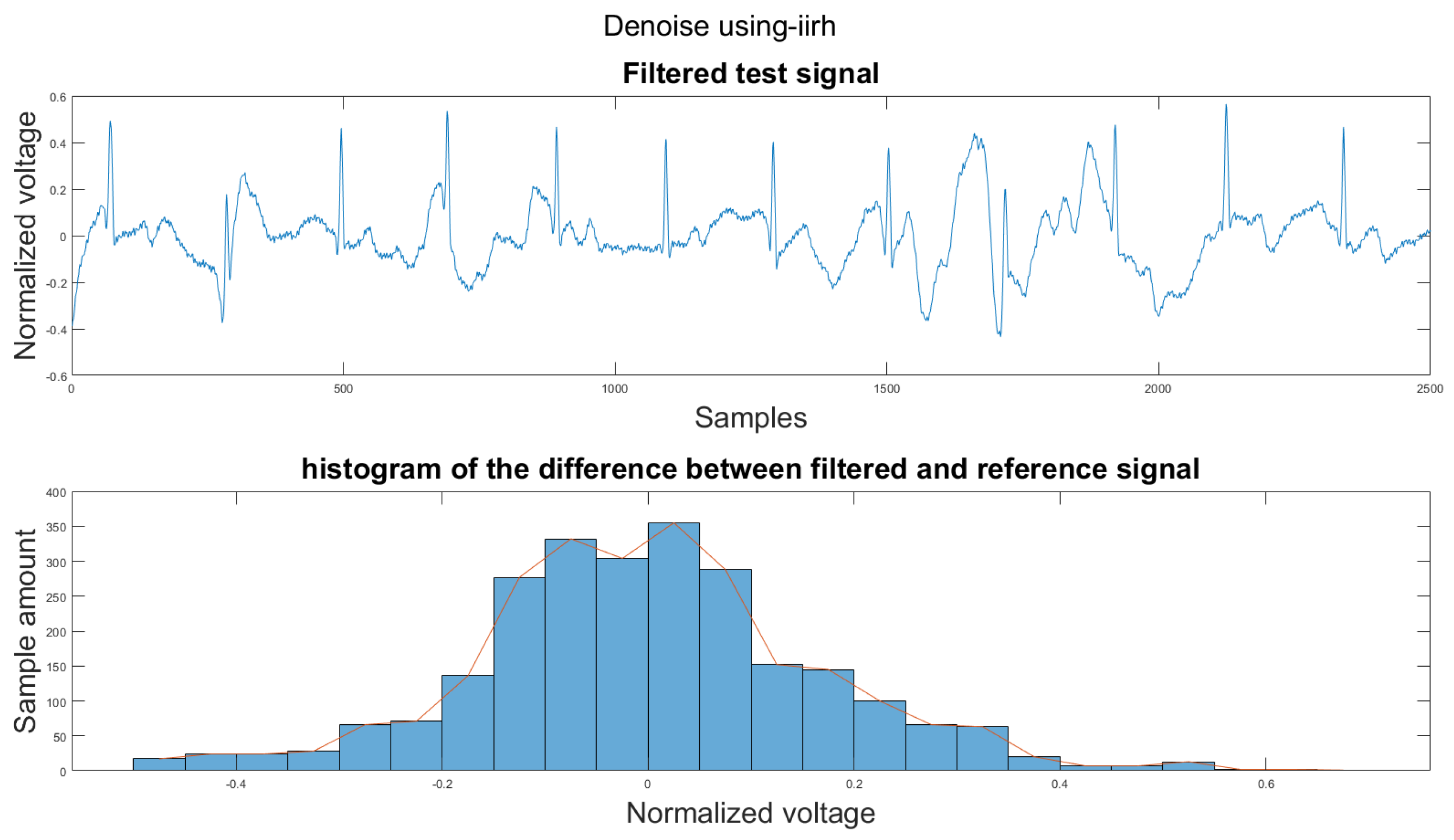
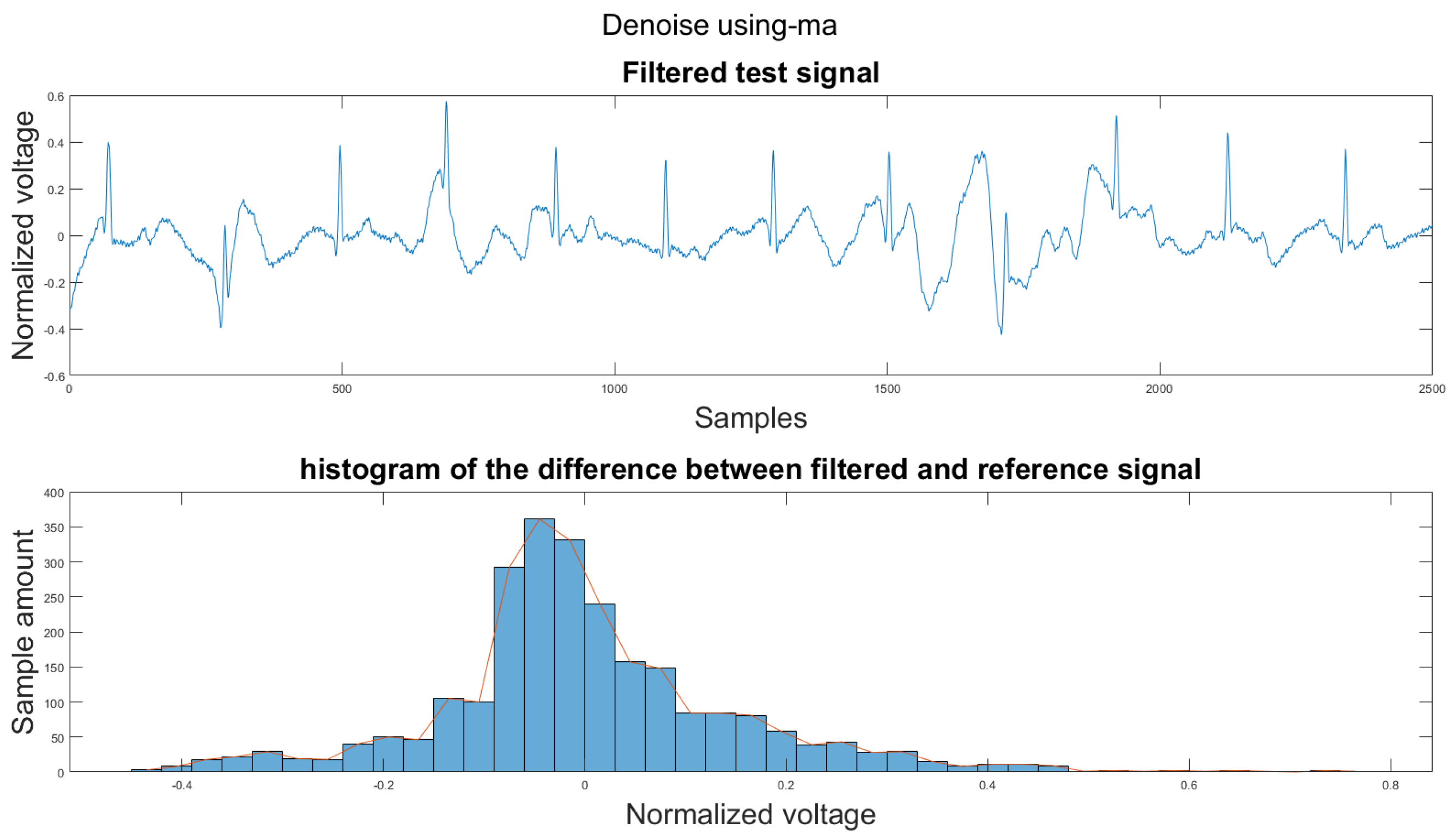
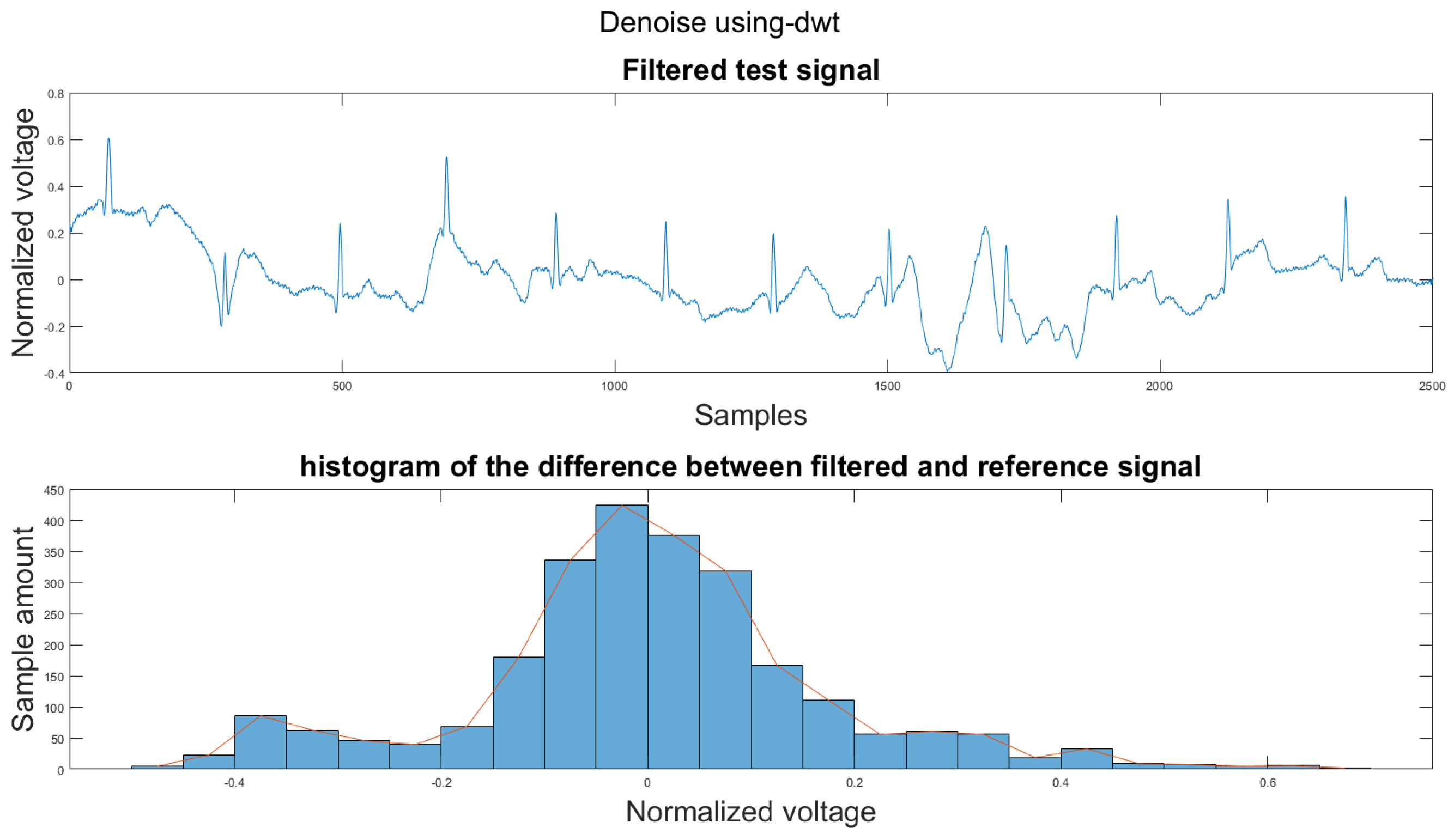
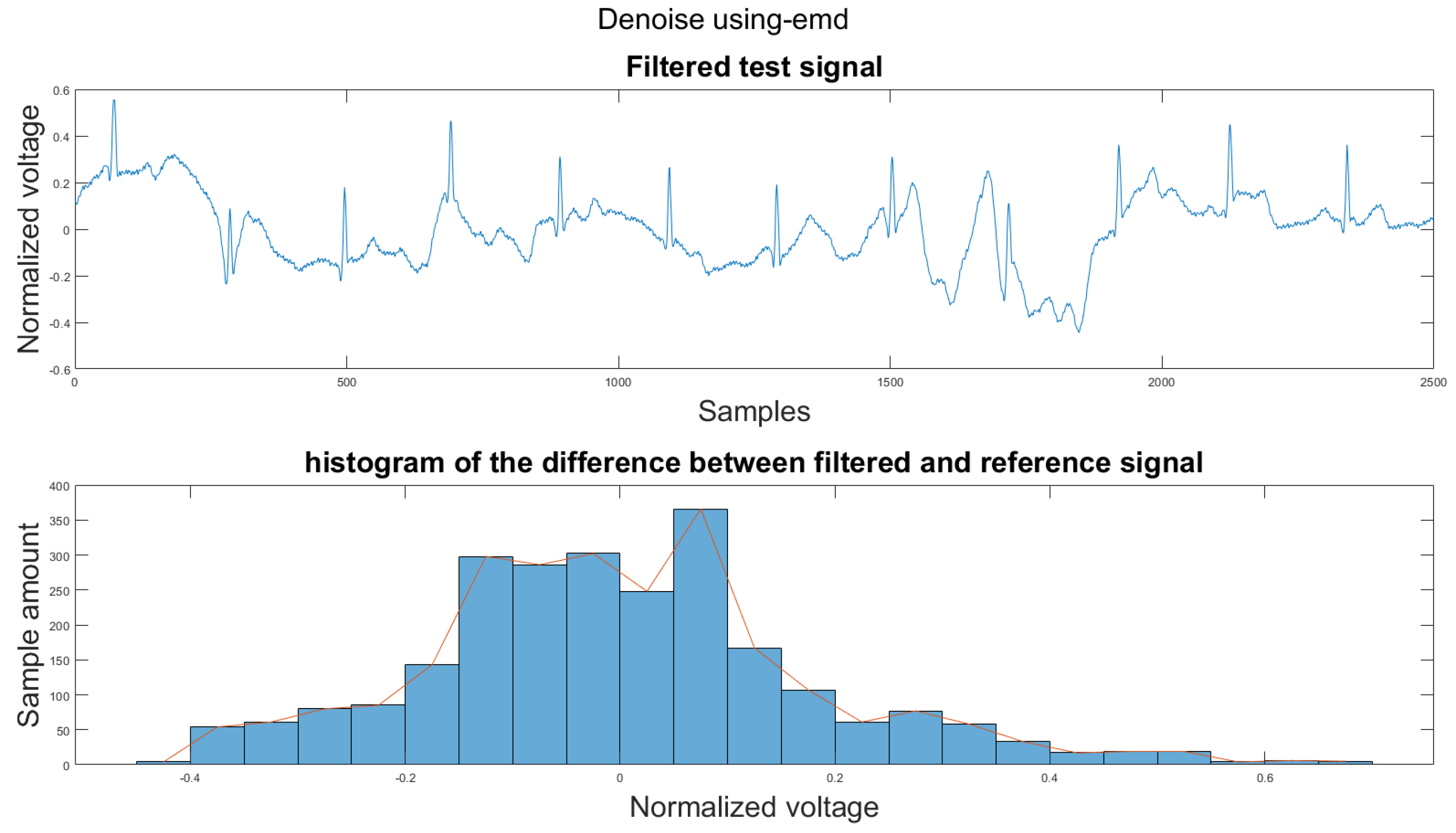
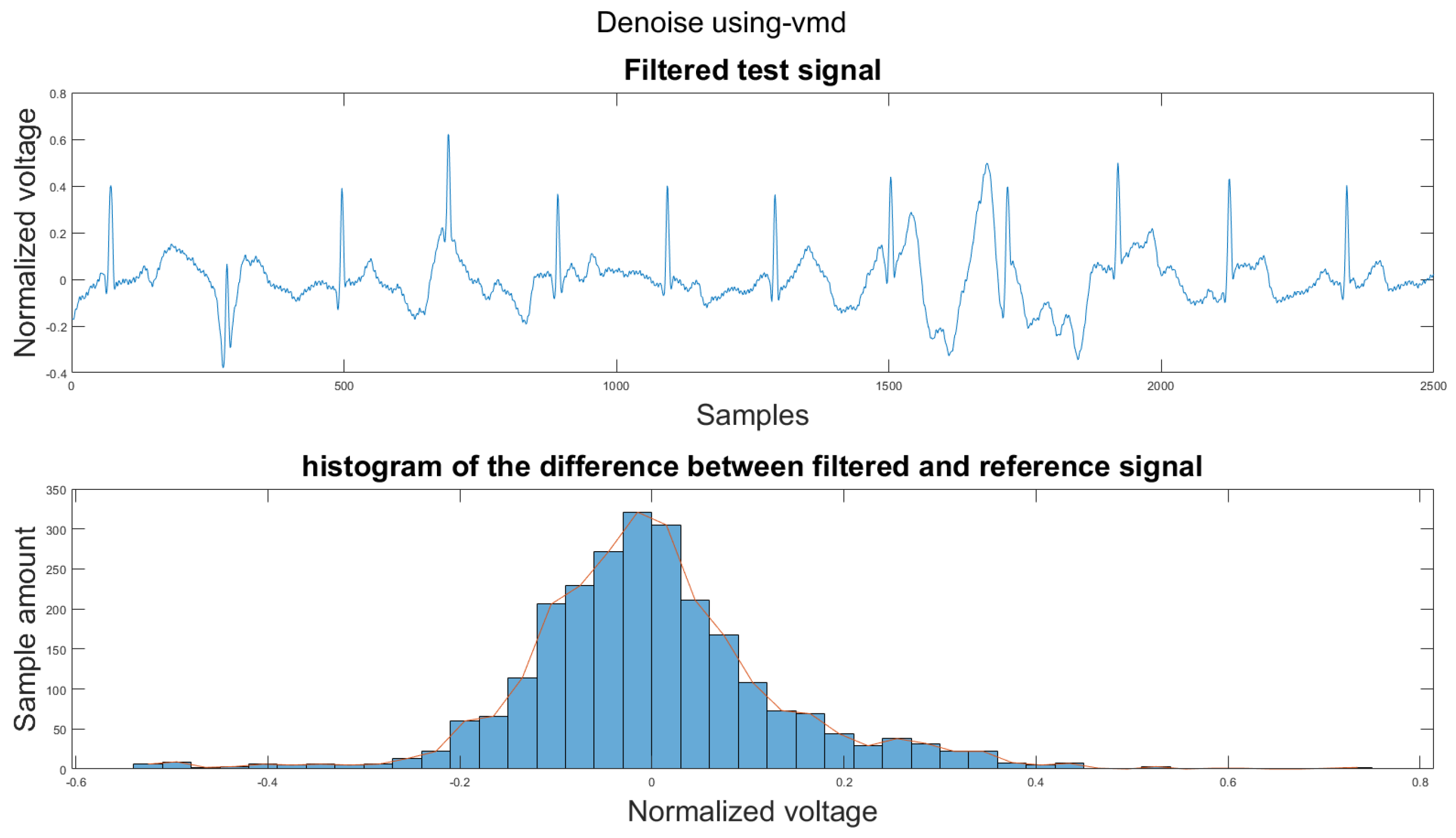

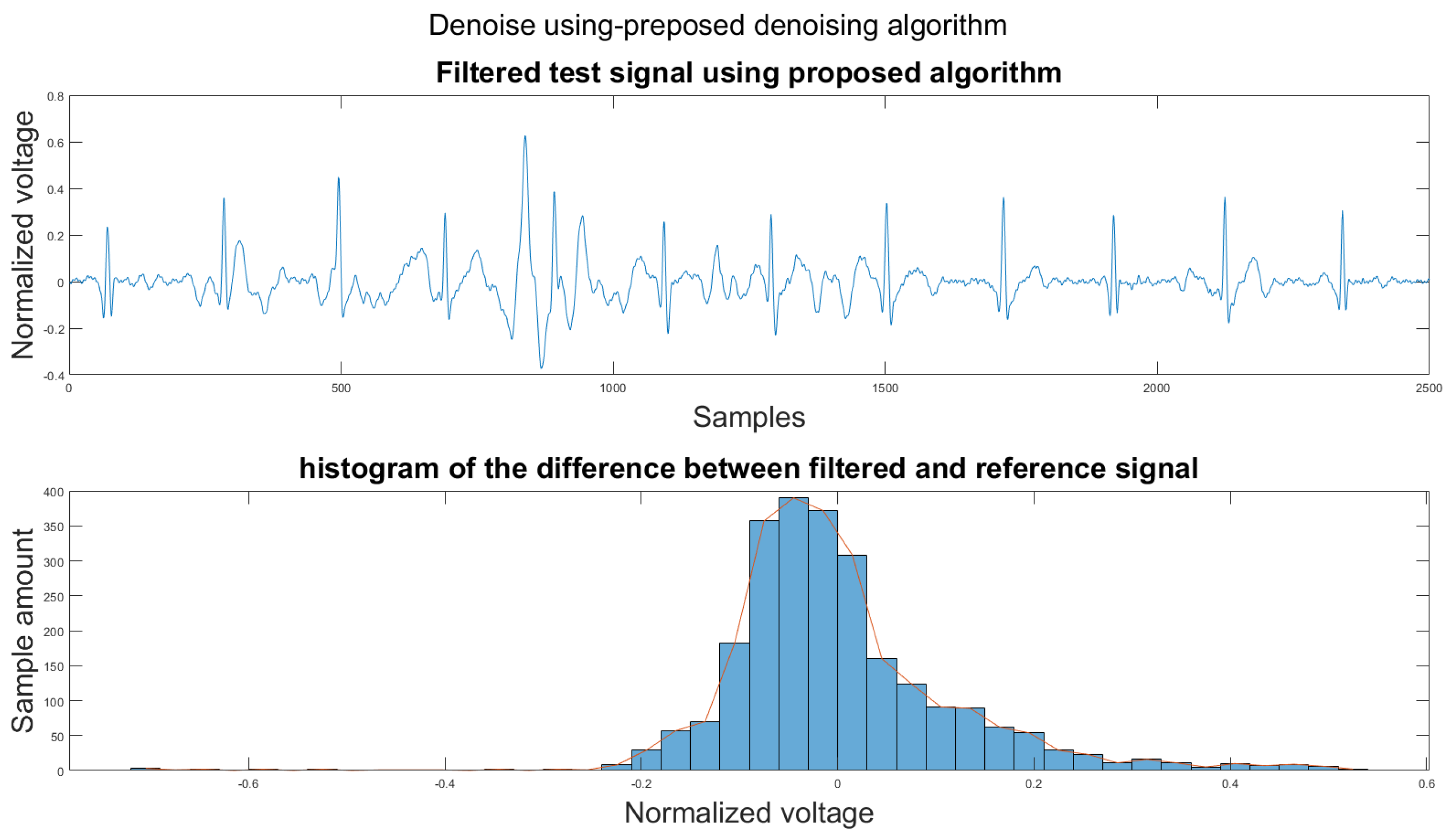

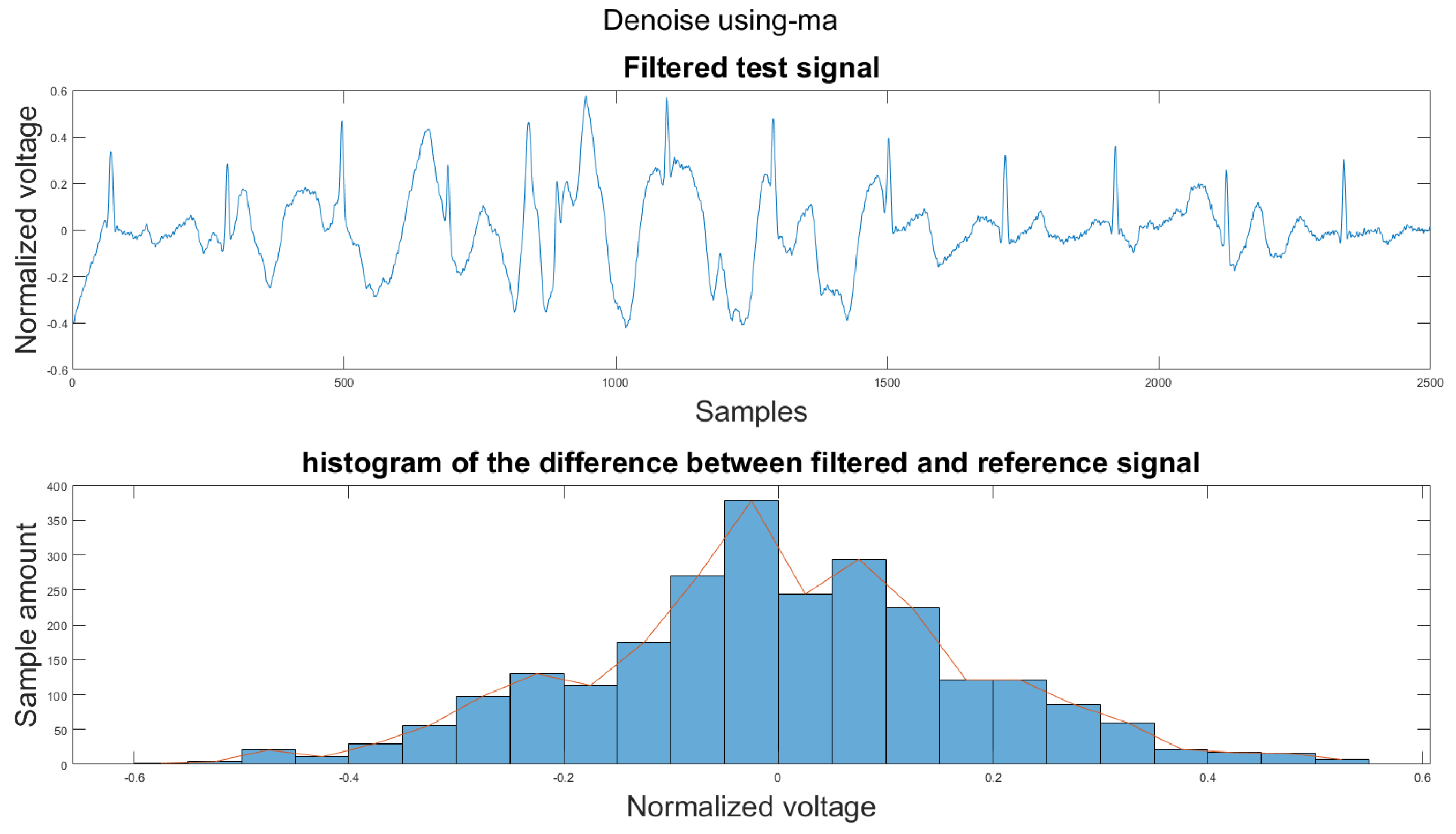
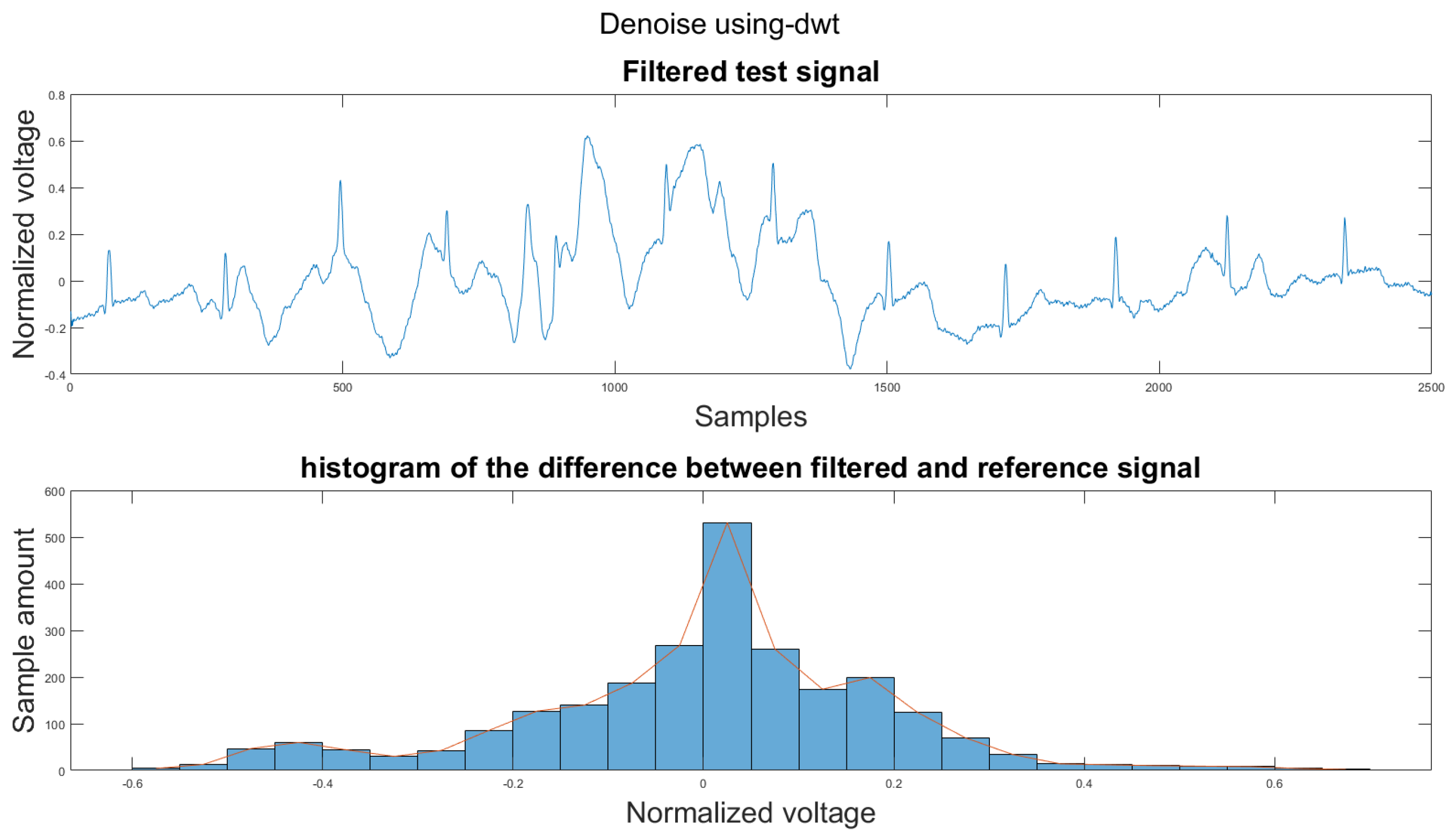
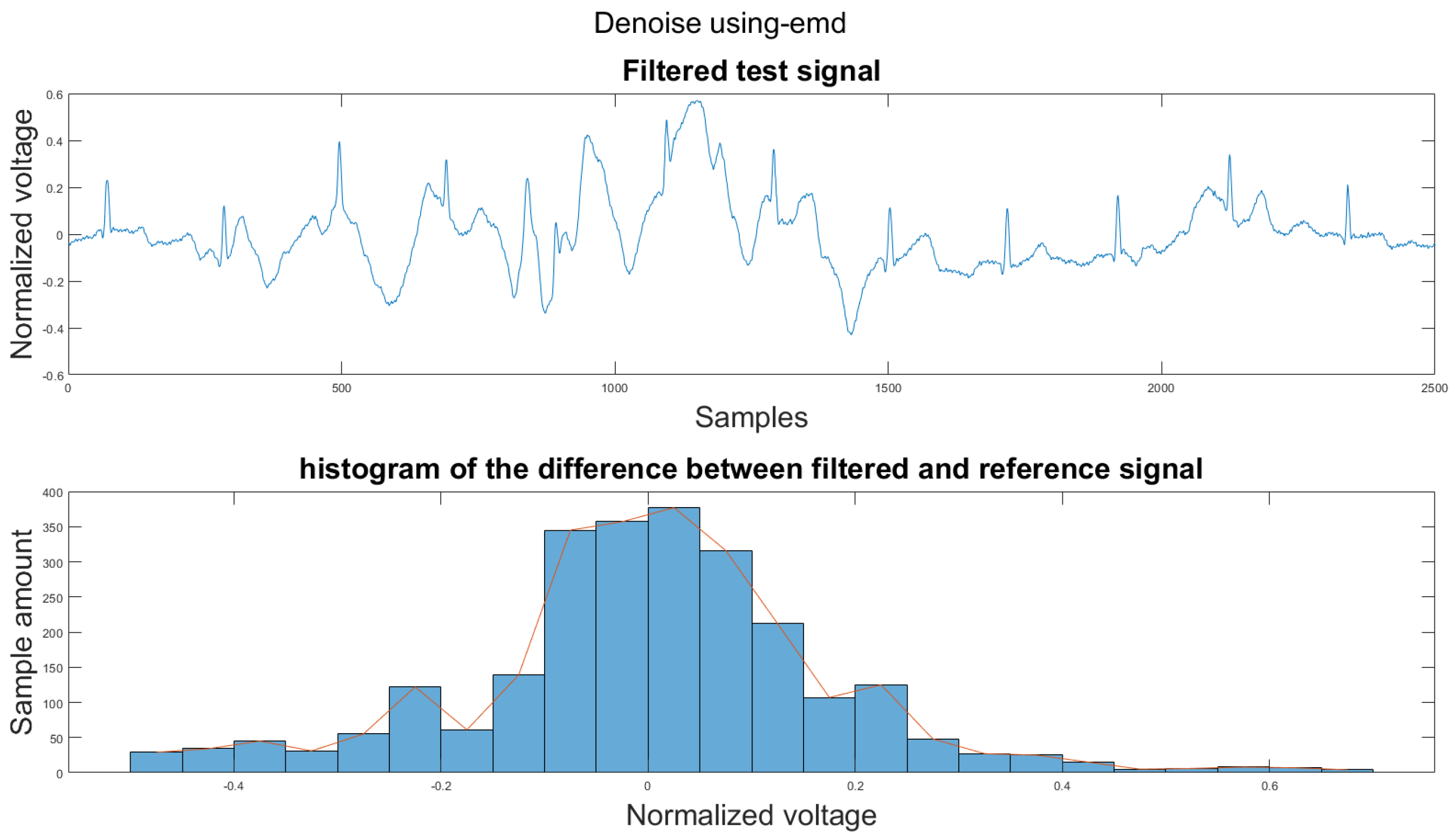
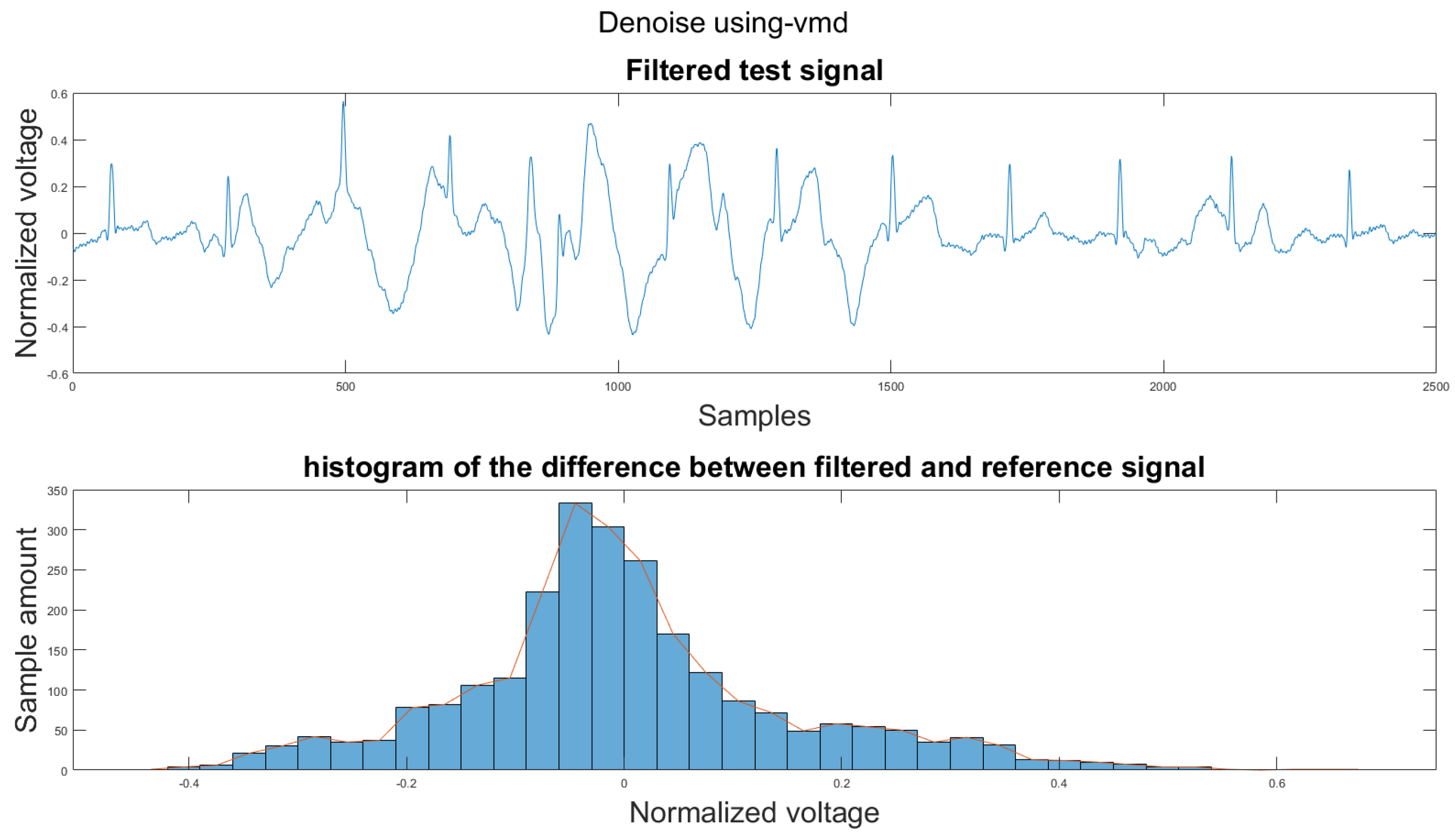
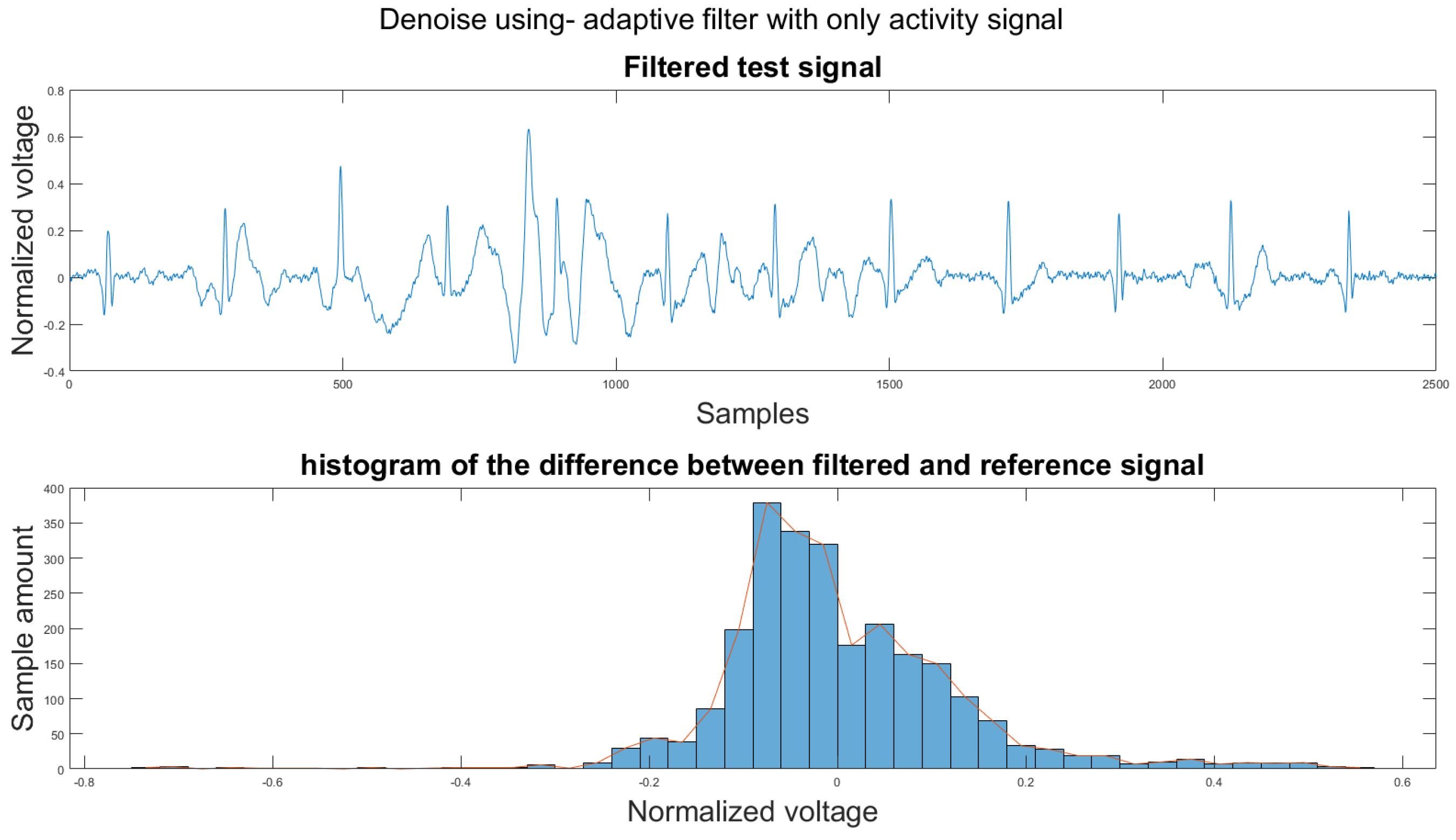
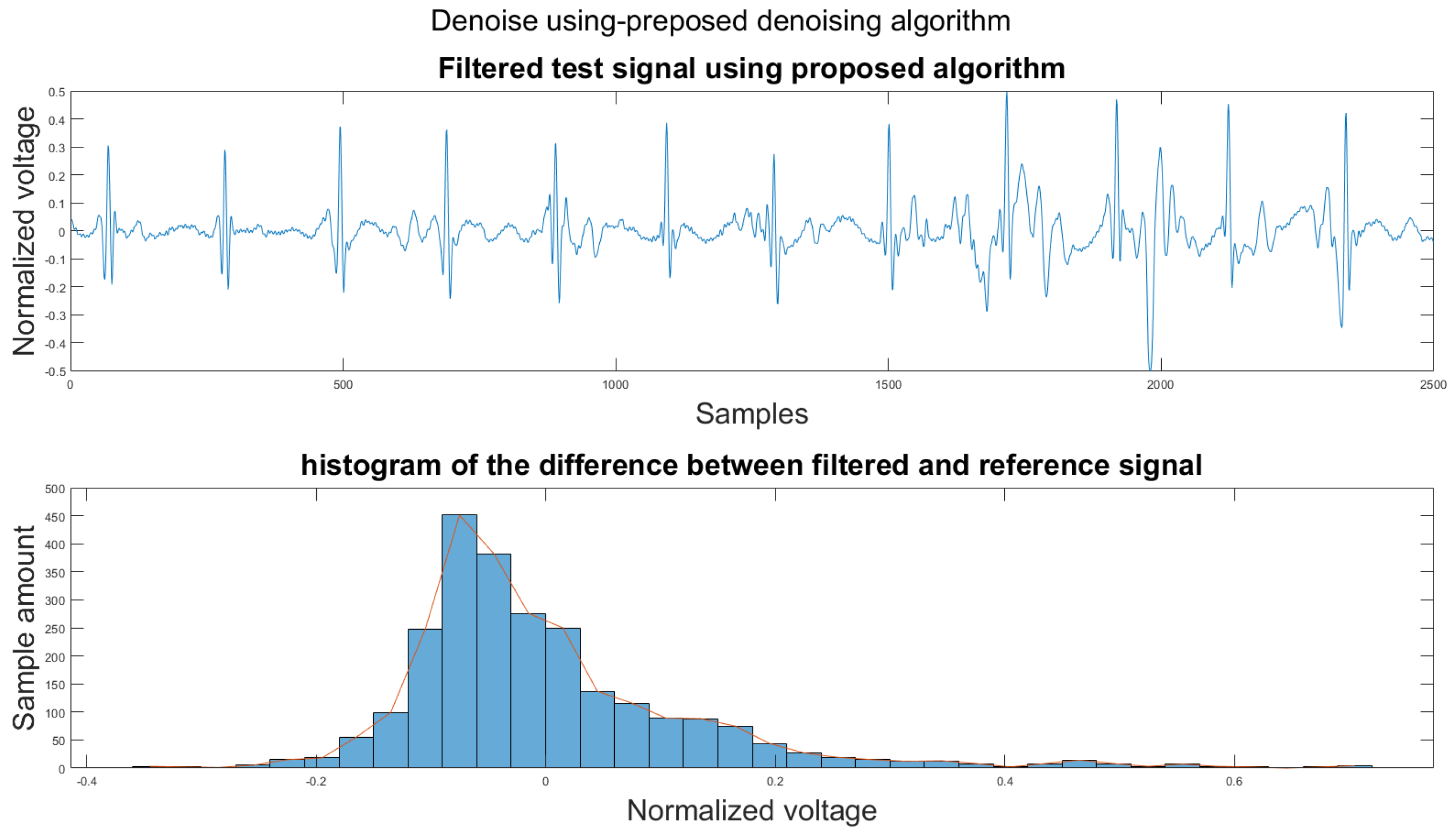
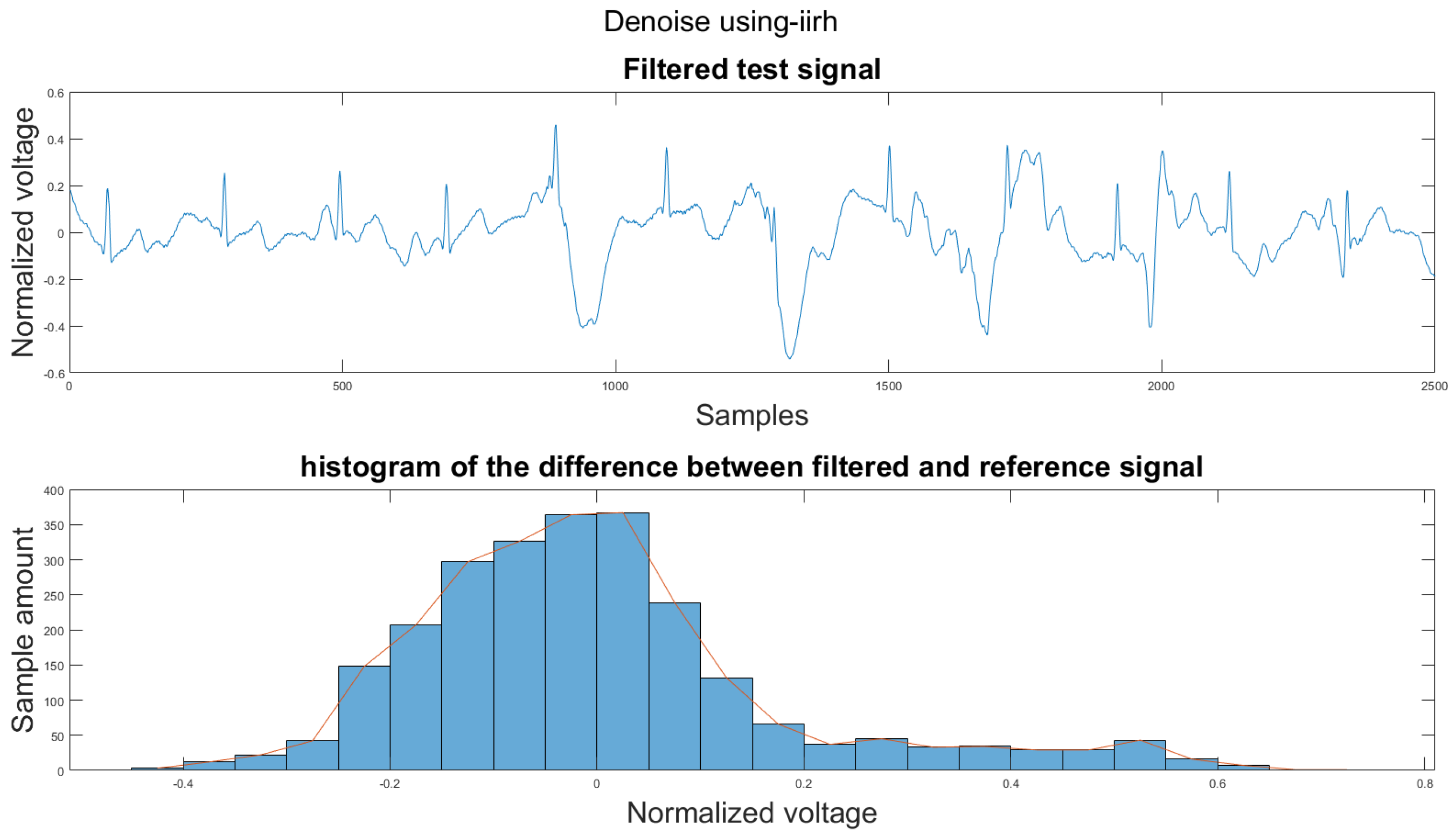
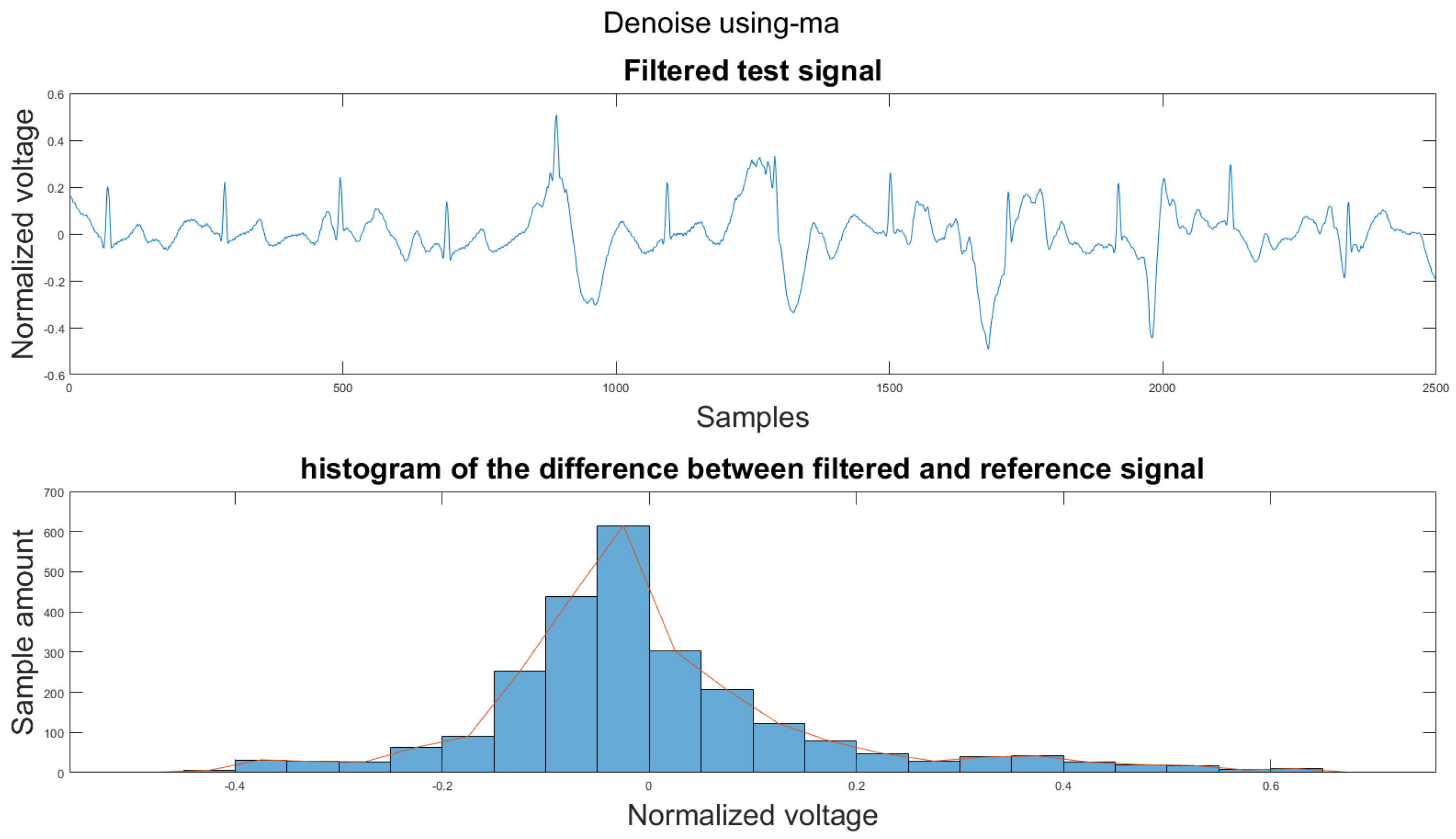
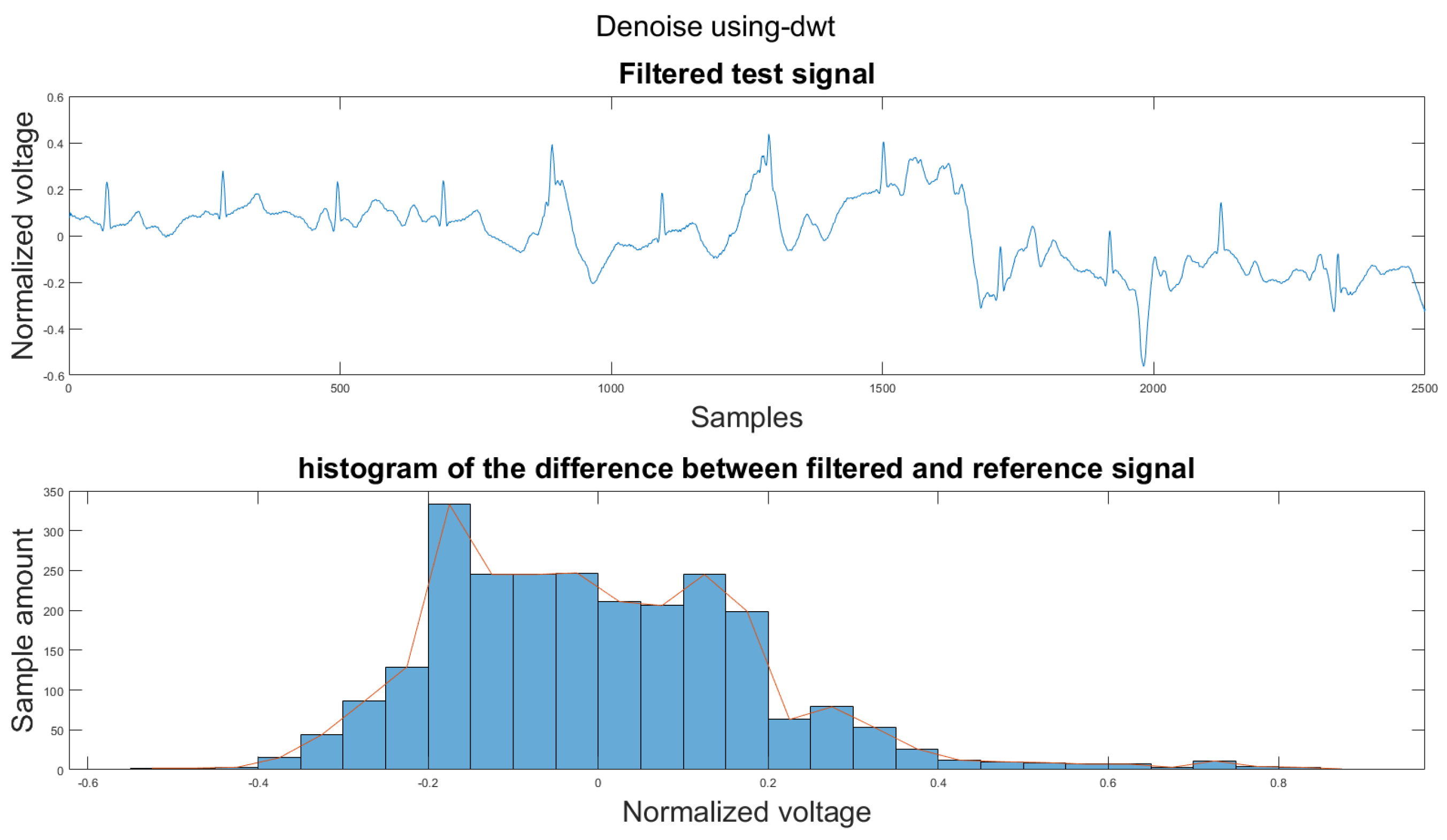
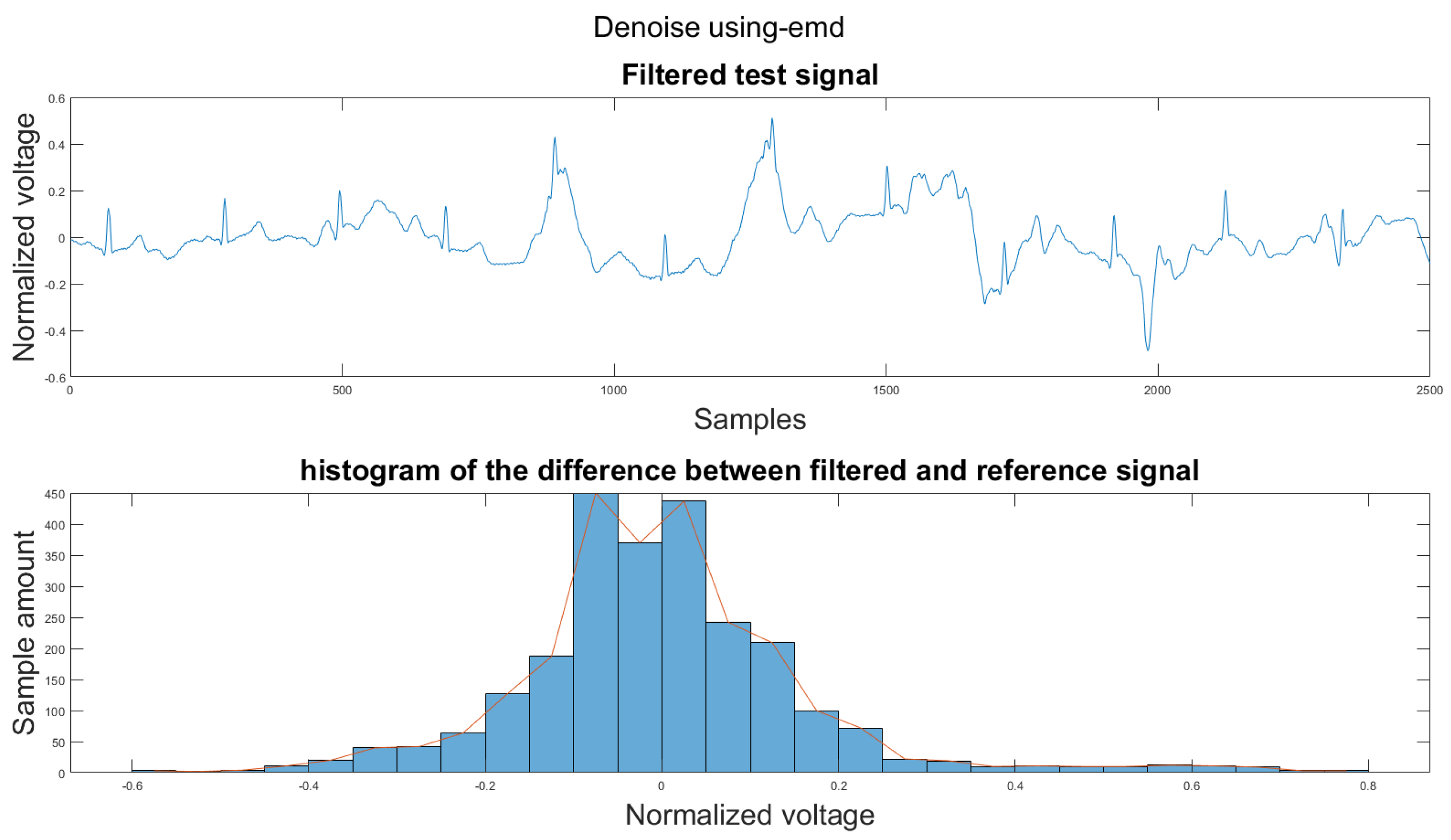
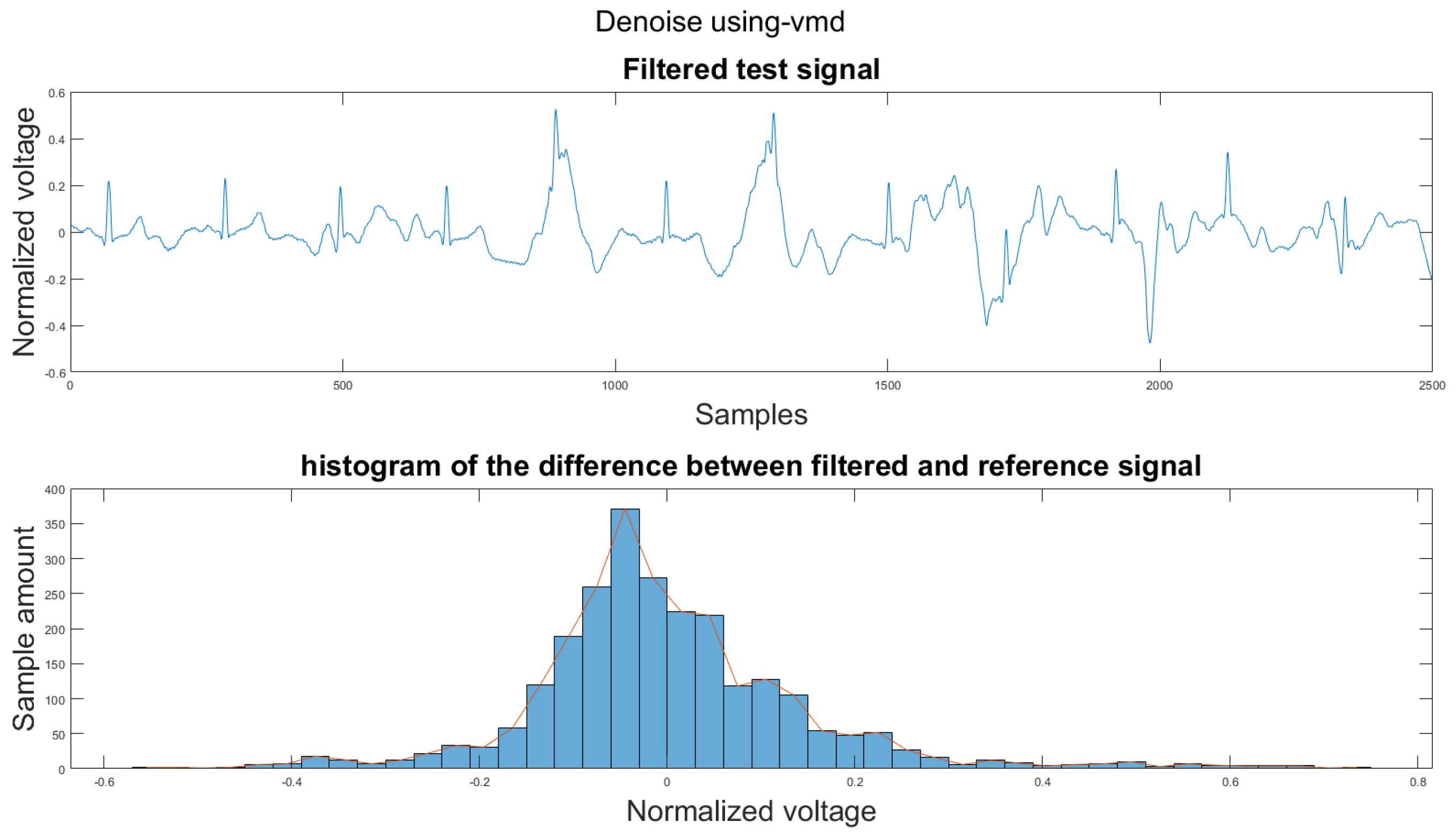


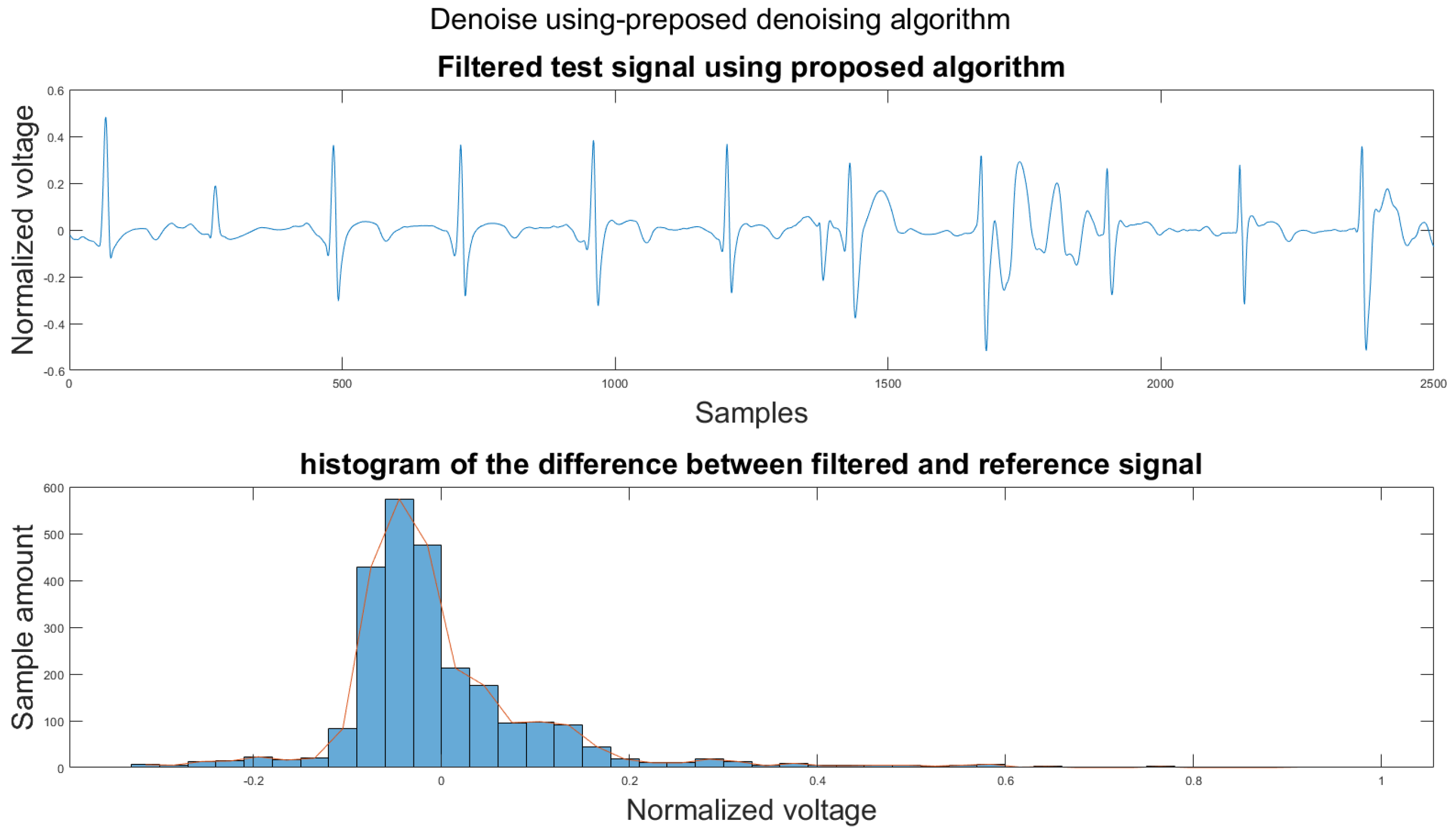

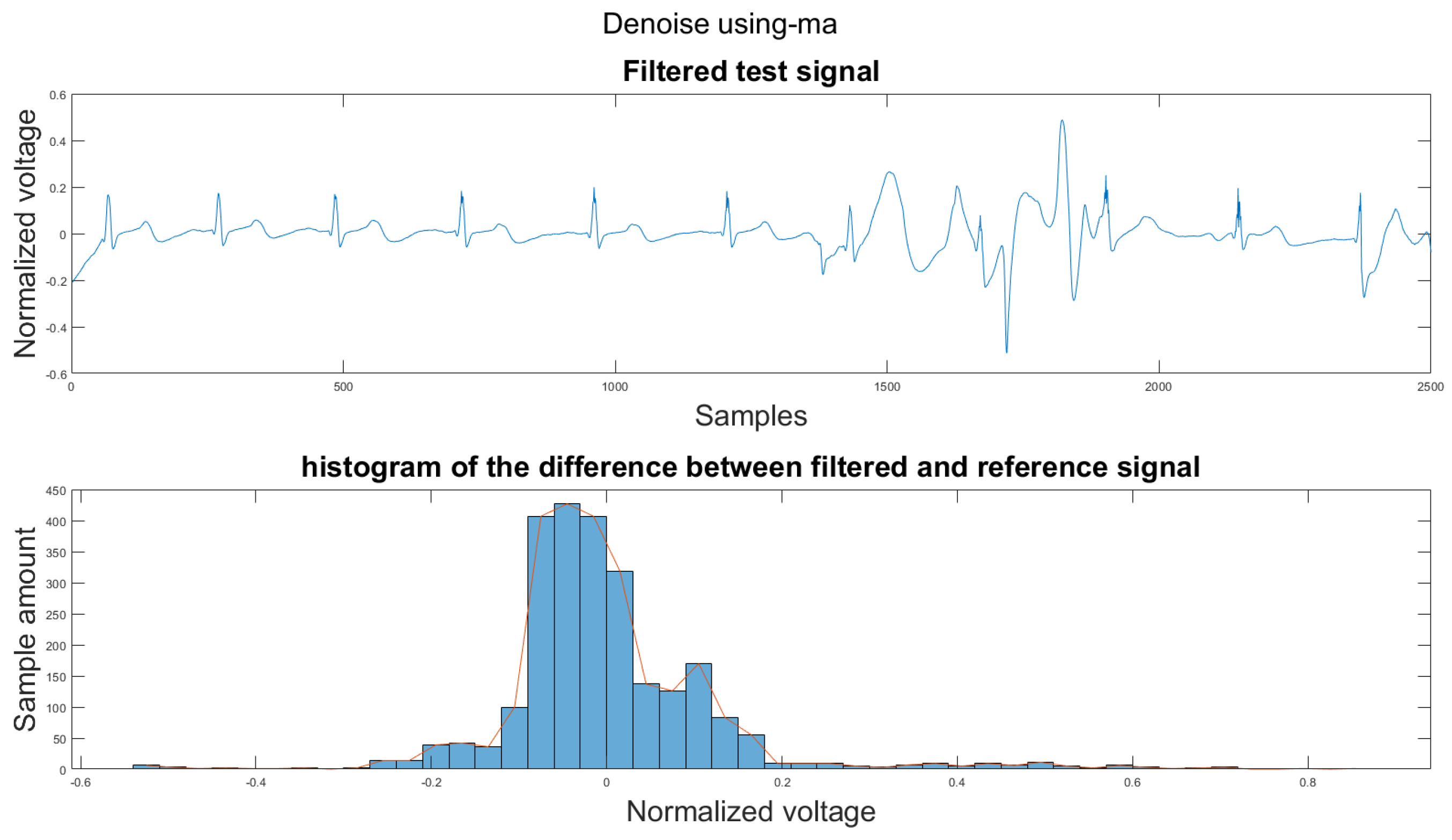

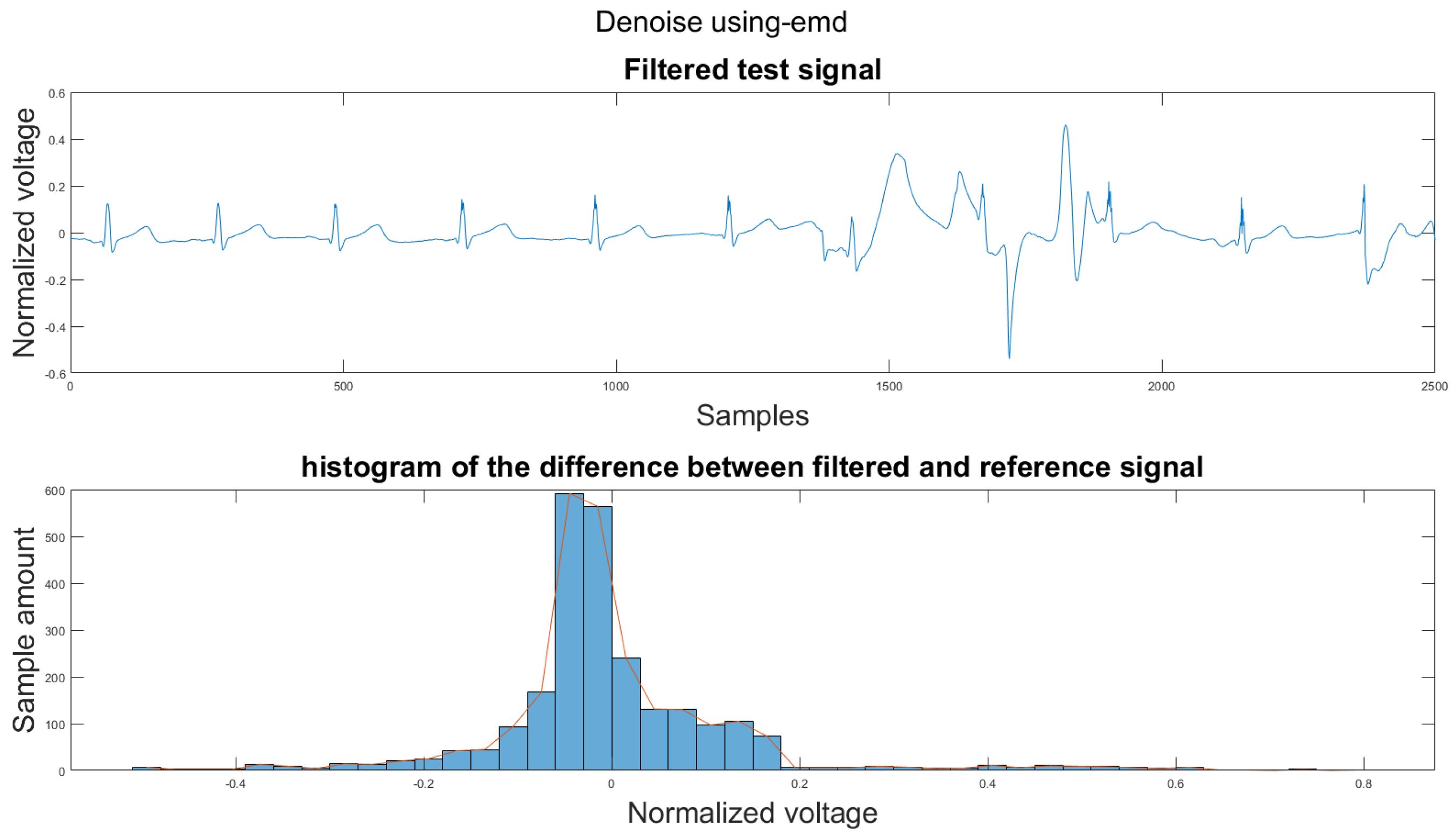


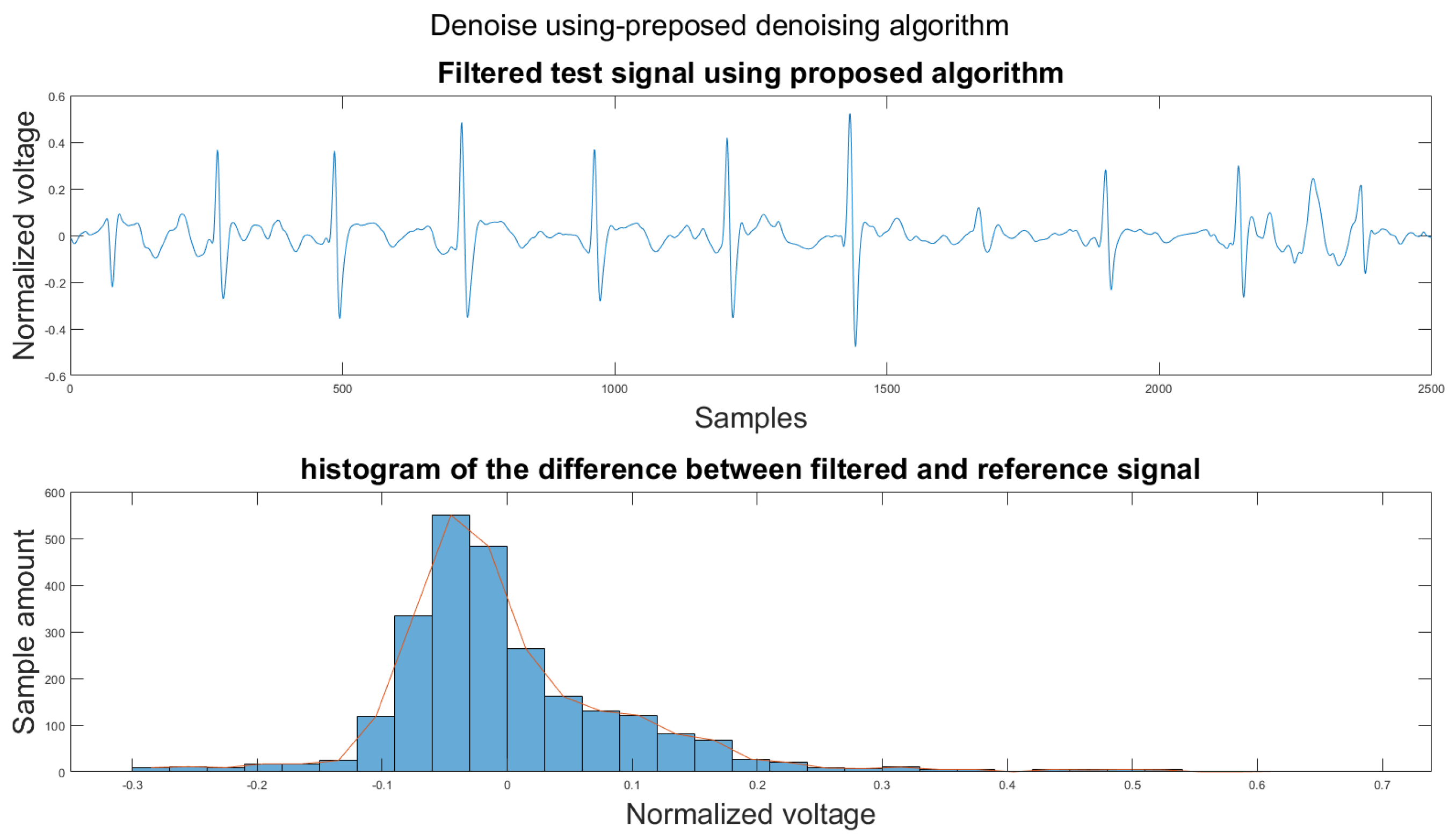
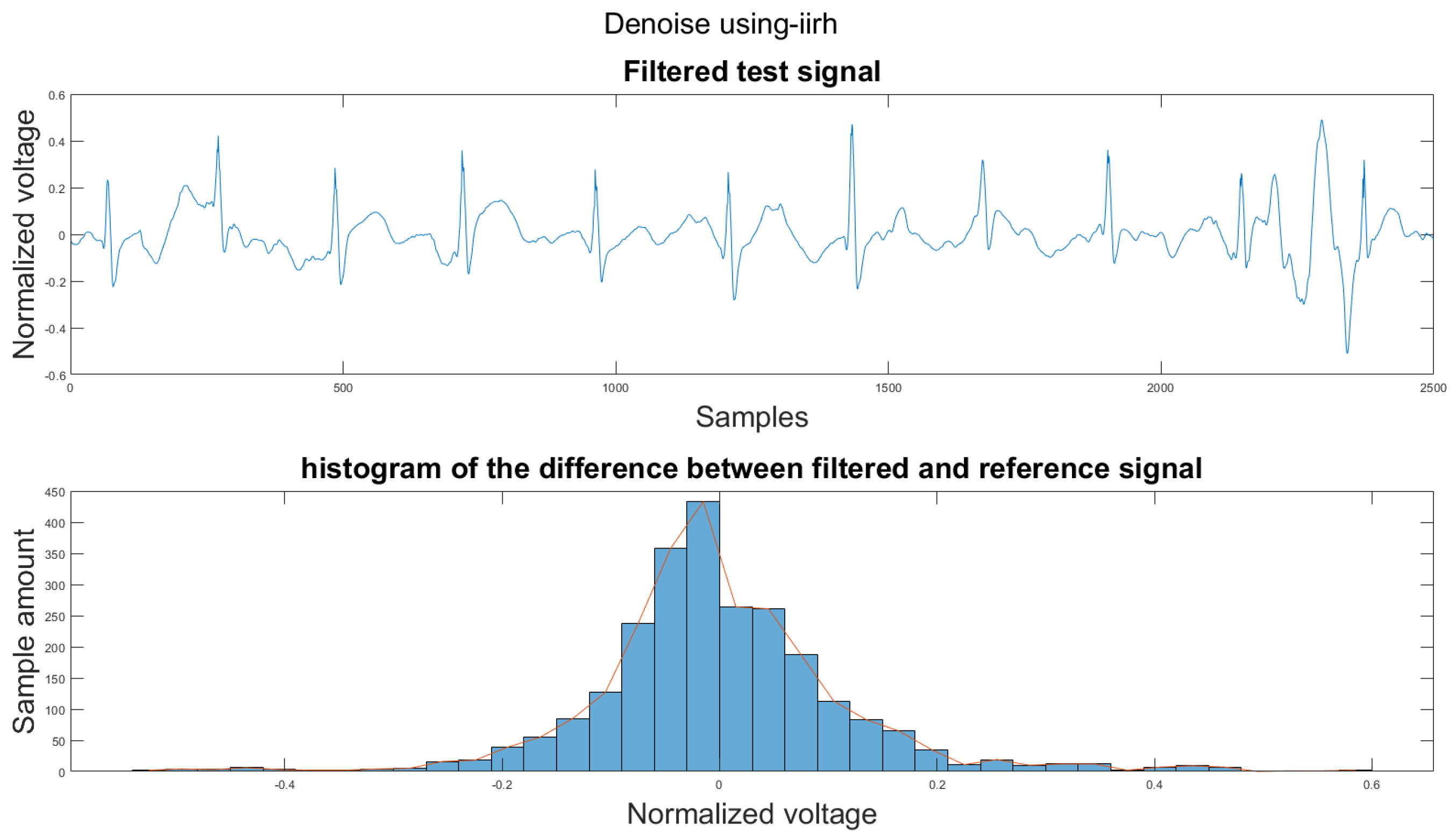

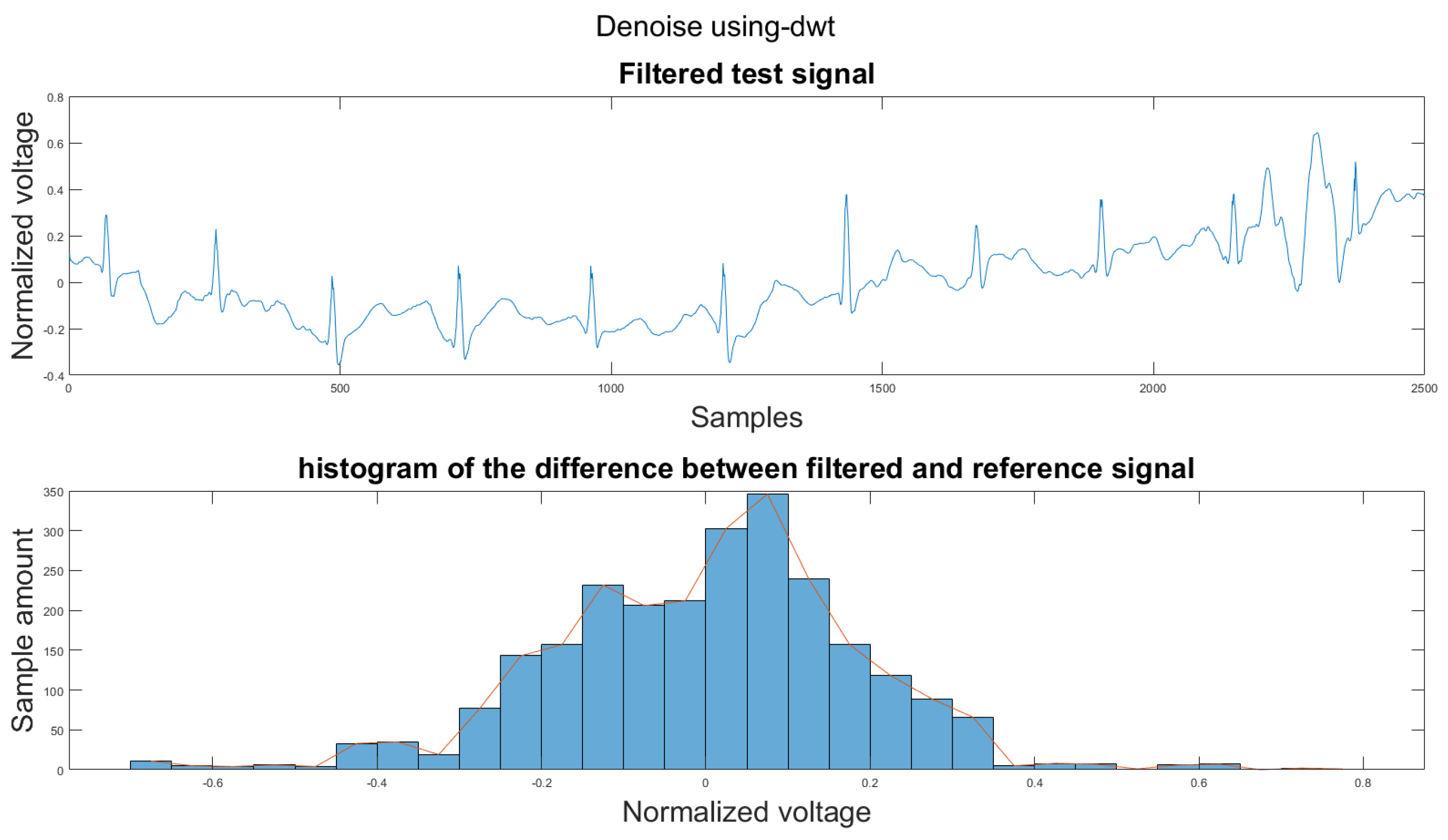
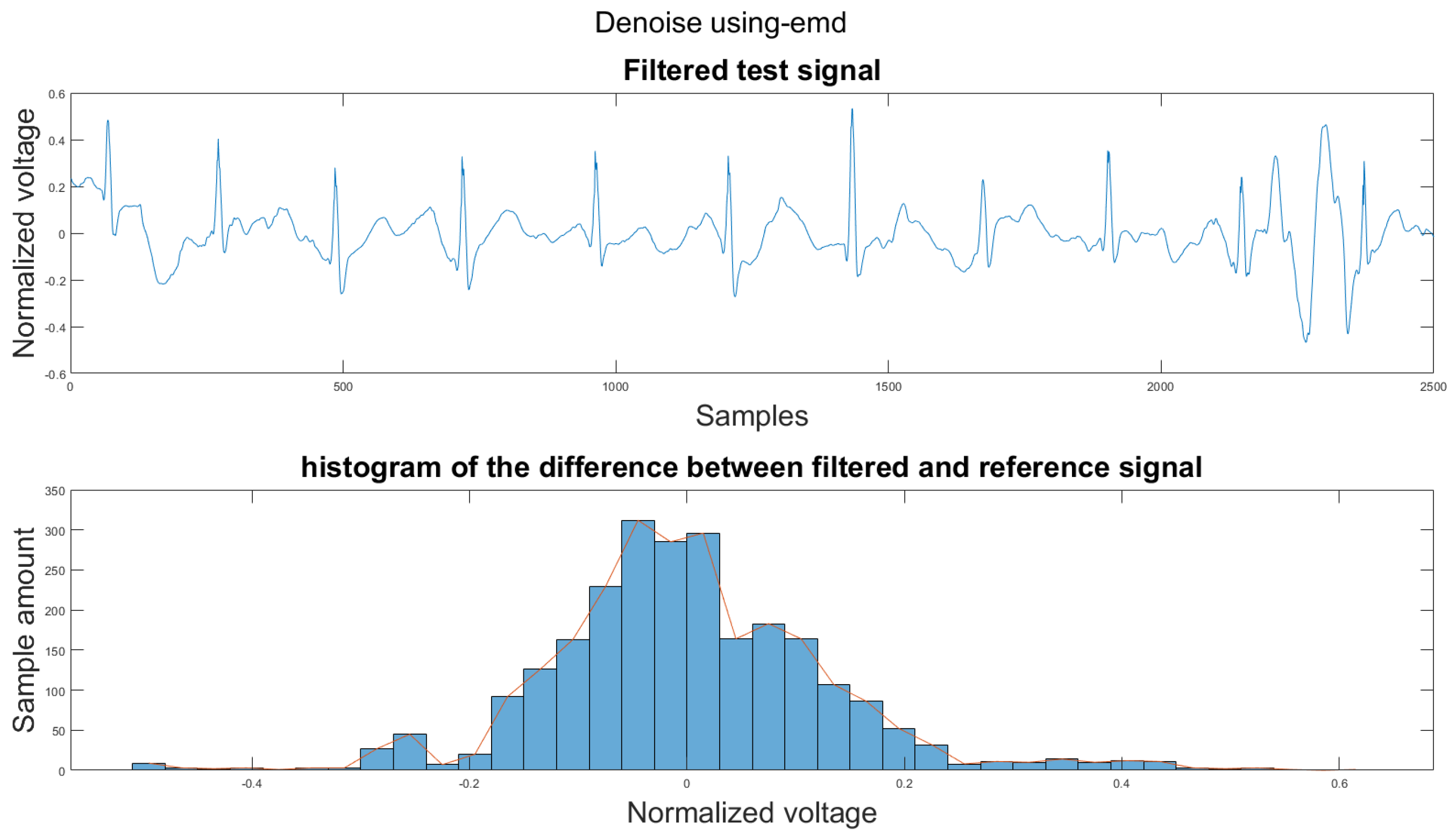


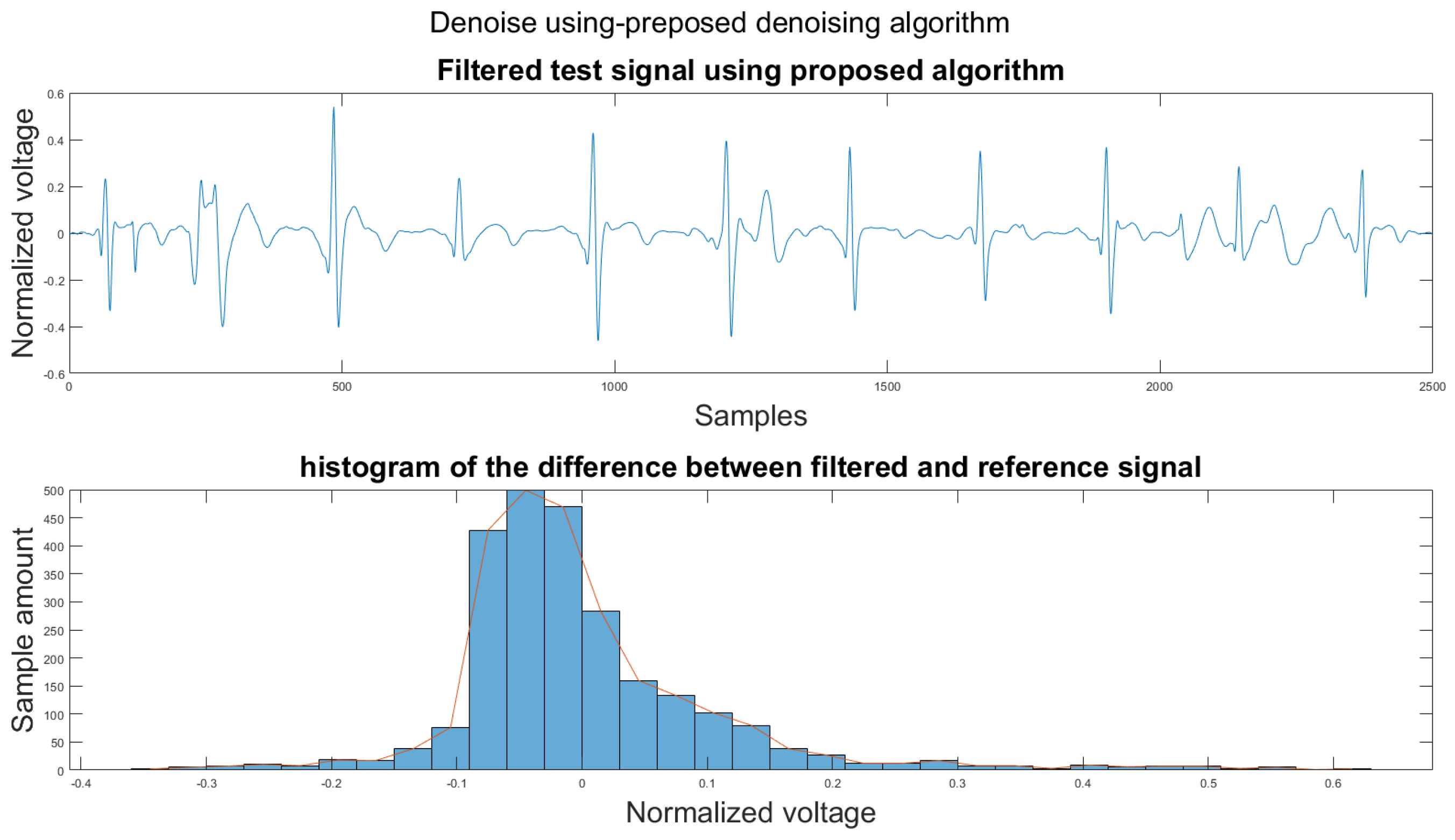
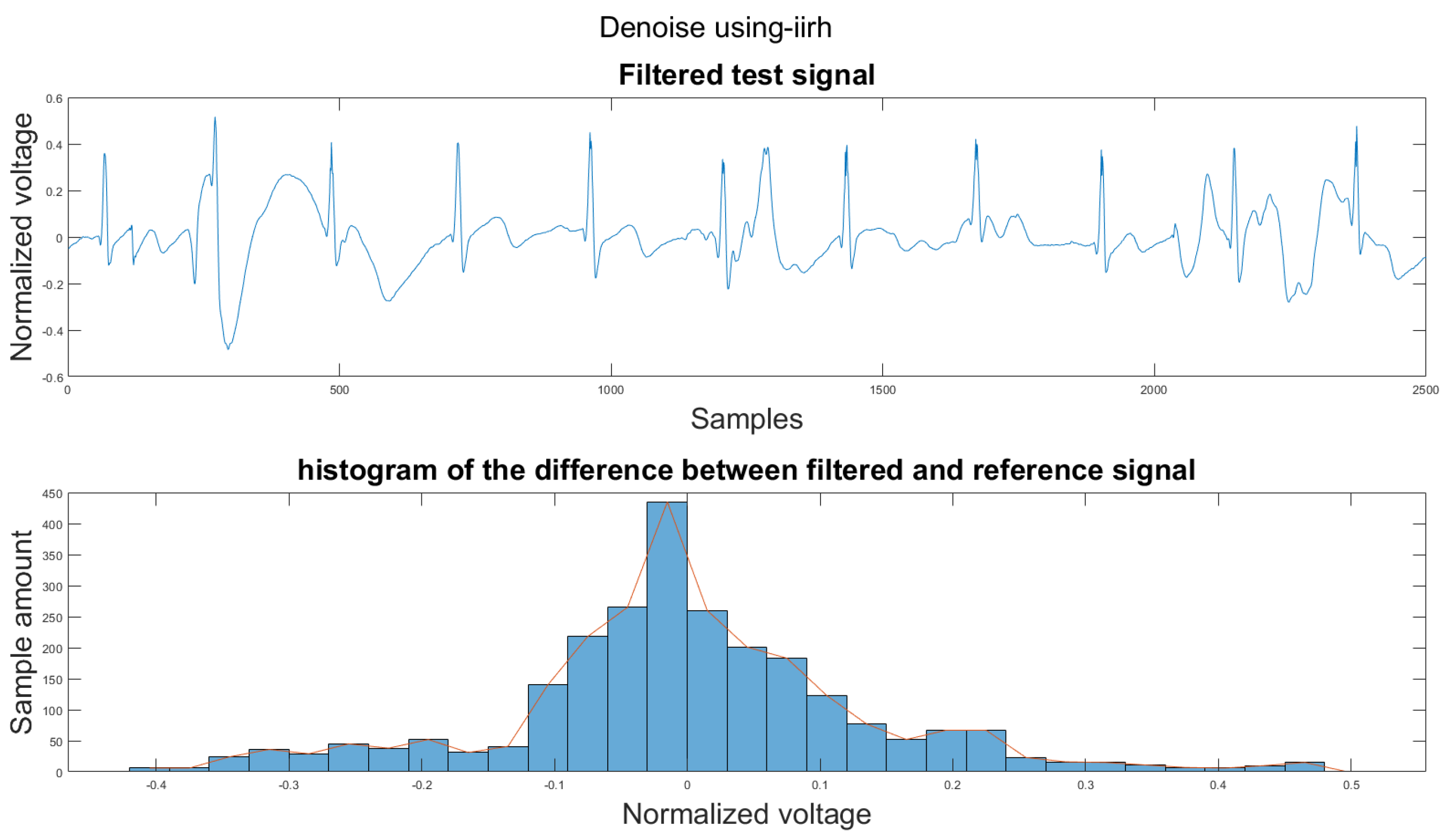

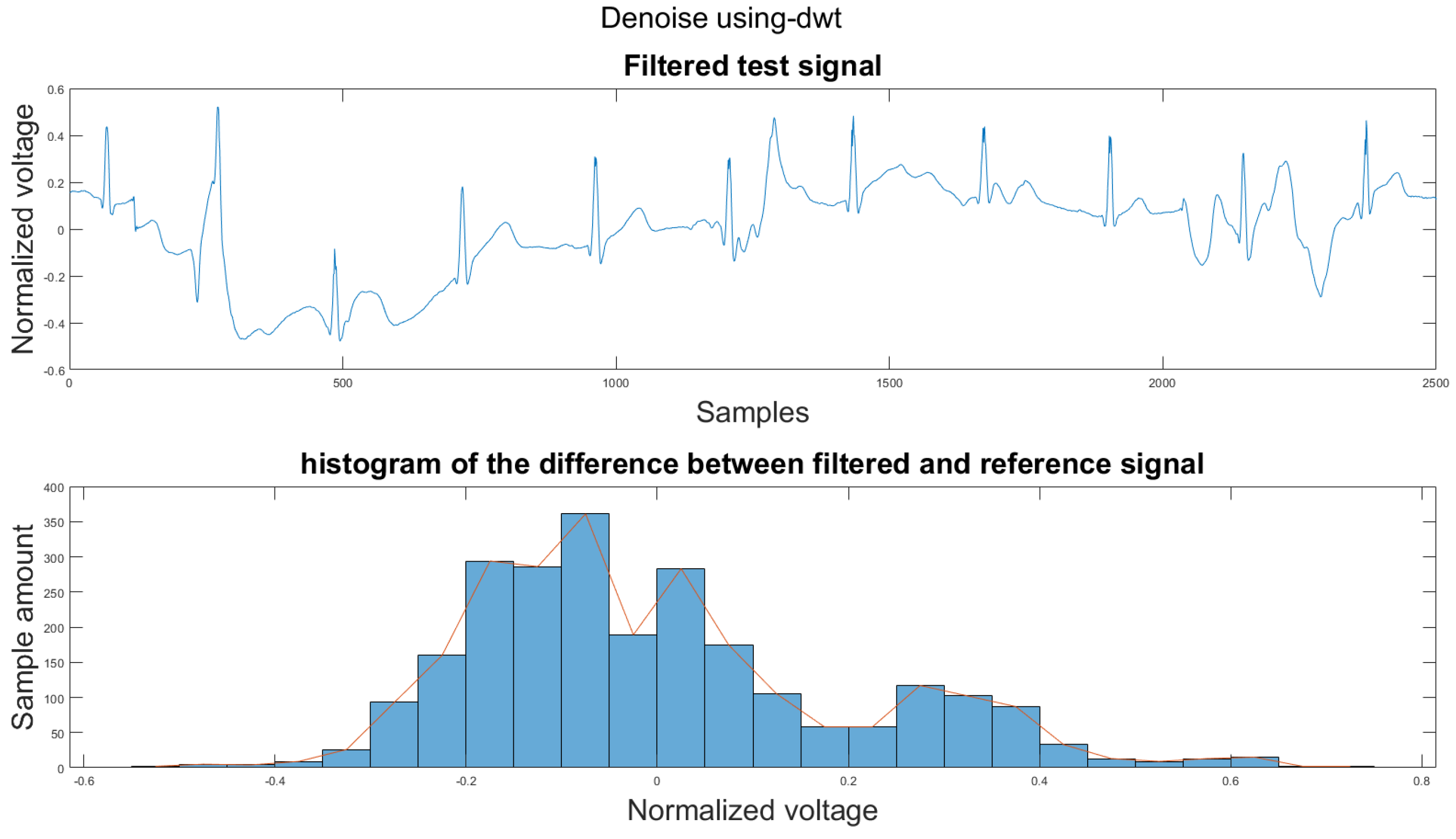

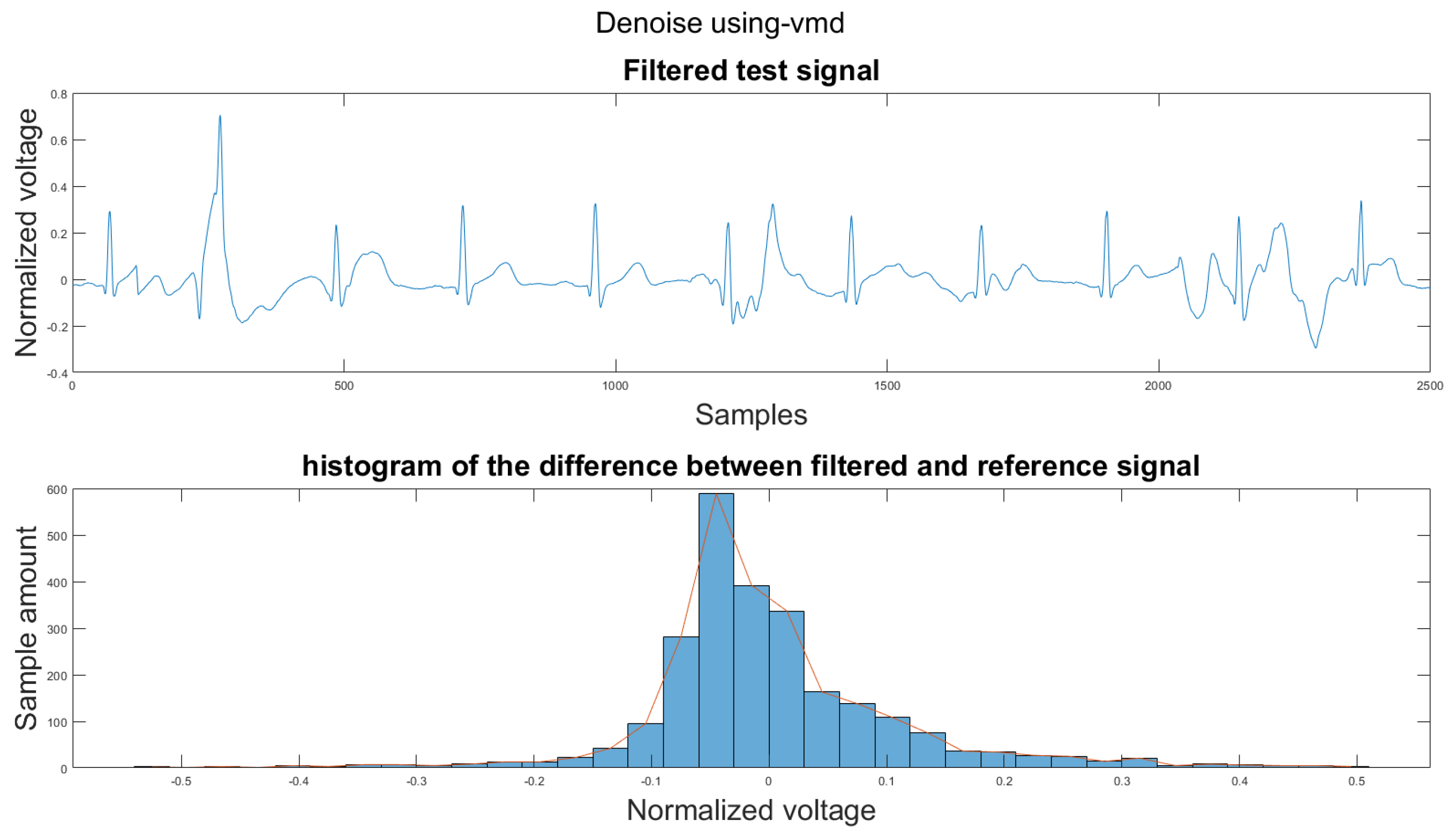

References
- Qardio Inc. QardioMD. 2018. Available online: https://www.getqardio.com/qardiomd-ecg/ (accessed on 10 November 2021).
- VIVALNK Inc. Vivalnk. 2014. Available online: https://www.vivalnk.com/products/medical-wearable-sensors/continuous-ecg-monitor (accessed on 10 November 2021).
- Carre Technologies Inc Astroskin. Available online: https://www.hexoskin.com/pages/astroskin-vital-signs-monitoring-platform-for-advanced-research (accessed on 10 November 2021).
- Richmond, S.; Wren, C. Early diagnosis of congenital heart disease. In Seminars in Neonatology; Elsevier: Amsterdam, The Netherlands, 2001; Volume 6, pp. 27–35. [Google Scholar]
- Smith, W.M.; Riddell, F.; Madon, M.; Gleva, M.J. Comparison of diagnostic value using a small, single channel, P-wave centric sternal ECG monitoring patch with a standard 3-lead Holter system over 24 hours. Am. Heart J. 2017, 185, 67–73. [Google Scholar] [CrossRef]
- Harrigan, R.A.; Chan, T.C.; Brady, W.J. Electrocardiographic electrode misplacement, misconnection, and artifact. J. Emerg. Med. 2012, 43, 1038–1044. [Google Scholar] [CrossRef]
- Li, H.; Boulanger, P. A Survey of Heart Anomaly Detection Using Ambulatory Electrocardiogram (ECG). Sensors 2020, 20, 1461. [Google Scholar] [CrossRef] [Green Version]
- Kiranyaz, S.; Ince, T.; Gabbouj, M. Real-time patient-specific ECG classification by 1-D convolutional neural networks. IEEE Trans. Biomed. Eng. 2015, 63, 664–675. [Google Scholar] [CrossRef]
- Lisheng, X.; Kuanquan, W.; Zhang, D.; Cheng, S. Adaptive baseline wander removal in the pulse waveform. In Proceedings of the 15th IEEE Symposium on Computer-Based Medical Systems (CBMS 2002), Maribor, Slovenia, 4–7 June 2002; pp. 143–148. [Google Scholar]
- Mallat, S.G. A theory for multiresolution signal decomposition: The wavelet representation. In Fundamental Papers in Wavelet Theory; Princeton University Press: Princeton, NJ, USA, 2009; pp. 494–513. [Google Scholar]
- Velayudhan, A.; Peter, S. Noise Analysis and Different Denoising Techniques of ECG Signal-A Survey. IOSR J. Electron. Commun. Eng. IOSR-JECE 2016, 1, 40–44. [Google Scholar]
- Poungponsri, S.; Yu, X.H. An adaptive filtering approach for electrocardiogram (ECG) signal noise reduction using neural networks. Neurocomputing 2013, 117, 206–213. [Google Scholar] [CrossRef]
- Huang, N.E.; Shen, Z.; Long, S.R.; Wu, M.C.; Shih, H.H.; Zheng, Q.; Yen, N.C.; Tung, C.C.; Liu, H.H. The empirical mode decomposition and the Hilbert spectrum for nonlinear and non-stationary time series analysis. Proc. R. Soc. Lond. Ser. A Math. Phys. Eng. Sci. 1998, 454, 903–995. [Google Scholar] [CrossRef]
- Weng, B.; Blanco-Velasco, M.; Barner, K.E. ECG denoising based on the empirical mode decomposition. In Proceedings of the 2006 International Conference of the IEEE Engineering in Medicine and Biology Society, New York, NY, USA, 30 August–3 September 2006; pp. 1–4. [Google Scholar]
- Blanco-Velasco, M.; Weng, B.; Barner, K.E. ECG signal denoising and baseline wander correction based on the empirical mode decomposition. Comput. Biol. Med. 2008, 38, 1–13. [Google Scholar] [CrossRef]
- Dragomiretskiy, K.; Zosso, D. Variational mode decomposition. IEEE Trans. Signal Process. 2013, 62, 531–544. [Google Scholar] [CrossRef]
- Maji, U.; Pal, S. Empirical mode decomposition vs. variational mode decomposition on ECG signal processing: A comparative study. In Proceedings of the 2016 International Conference on Advances in Computing, Communications and Informatics (ICACCI), Jaipur, India, 21–24 September 2016; pp. 1129–1134. [Google Scholar]
- Thakor, N.V.; Zhu, Y.S. Applications of adaptive filtering to ECG analysis: Noise cancellation and arrhythmia detection. IEEE Trans. Biomed. Eng. 1991, 38, 785–794. [Google Scholar] [CrossRef] [PubMed]
- Haykin, S.S.; Widrow, B.; Widrow, B. Least-Mean-Square Adaptive Filters. Wiley Online Library. 2013, Volume 31. Available online: https://onlinelibrary.wiley.com/doi/book/10.1002/0471461288 (accessed on 20 November 2021).
- Thenua, R.K.; Agarwal, S. Simulation and performance analysis of adaptive filter in noise cancellation. Int. J. Eng. Sci. Technol. 2010, 2, 4373–4378. [Google Scholar]
- Raya, M.A.D.; Sison, L.G. Adaptive noise cancelling of motion artifact in stress ECG signals using accelerometer. In Proceedings of the Second Joint 24th Annual Conference and the Annual Fall Meeting of the Biomedical Engineering Society Engineering in Medicine and Biology, Houston, TX, USA, 23–26 October 2002; Volume 2, pp. 1756–1757. [Google Scholar]
- Xiong, F.; Chen, D.; Huang, M. A wavelet adaptive cancellation algorithm based on multi-inertial sensors for the reduction of motion artifacts in ambulatory ECGs. Sensors 2020, 20, 970. [Google Scholar] [CrossRef] [Green Version]
- Patro, S.; Sahu, K.K. Normalization: A preprocessing stage. arXiv 2015, arXiv:1503.06462. [Google Scholar] [CrossRef]
- Noble, W.S. What is a support vector machine? Nat. Biotechnol. 2006, 24, 1565–1567. [Google Scholar] [CrossRef]
- Widodo, A.; Yang, B.S. Support vector machine in machine condition monitoring and fault diagnosis. Mech. Syst. Signal Process. 2007, 21, 2560–2574. [Google Scholar] [CrossRef]
- Durgesh, K.S.; Lekha, B. Data classification using support vector machine. J. Theor. Appl. Inf. Technol. 2010, 12, 1–7. [Google Scholar]
- Pan, J.; Tompkins, W.J. A real-time QRS detection algorithm. IEEE Trans. Biomed. Eng 1985, 32, 230–236. [Google Scholar] [CrossRef] [PubMed]
- Widrow, B.; McCool, J.; Ball, M. The complex LMS algorithm. Proc. IEEE 1975, 63, 719–720. [Google Scholar] [CrossRef]
- Dhiman, J.; Ahmad, S.; Gulia, K. Comparison between Adaptive filter Algorithms (LMS, NLMS and RLS). Int. J. Sci. Eng. Technol. Res. IJSETR 2013, 2, 1100–1103. [Google Scholar]
- Chaturvedi, A.; Raj, K.; Kumar, A. A comparative analysis of LMS and NLMS algorithms for adaptive filtration of compressed ECG signal. In Proceedings of the 2012 2nd International Conference on Power, Control and Embedded Systems, Allahabad, India, 17–19 December 2012; pp. 1–6. [Google Scholar]
- An, X.; K Stylios, G. Comparison of motion artefact reduction methods and the implementation of adaptive motion artefact reduction in wearable electrocardiogram monitoring. Sensors 2020, 20, 1468. [Google Scholar] [CrossRef] [PubMed] [Green Version]

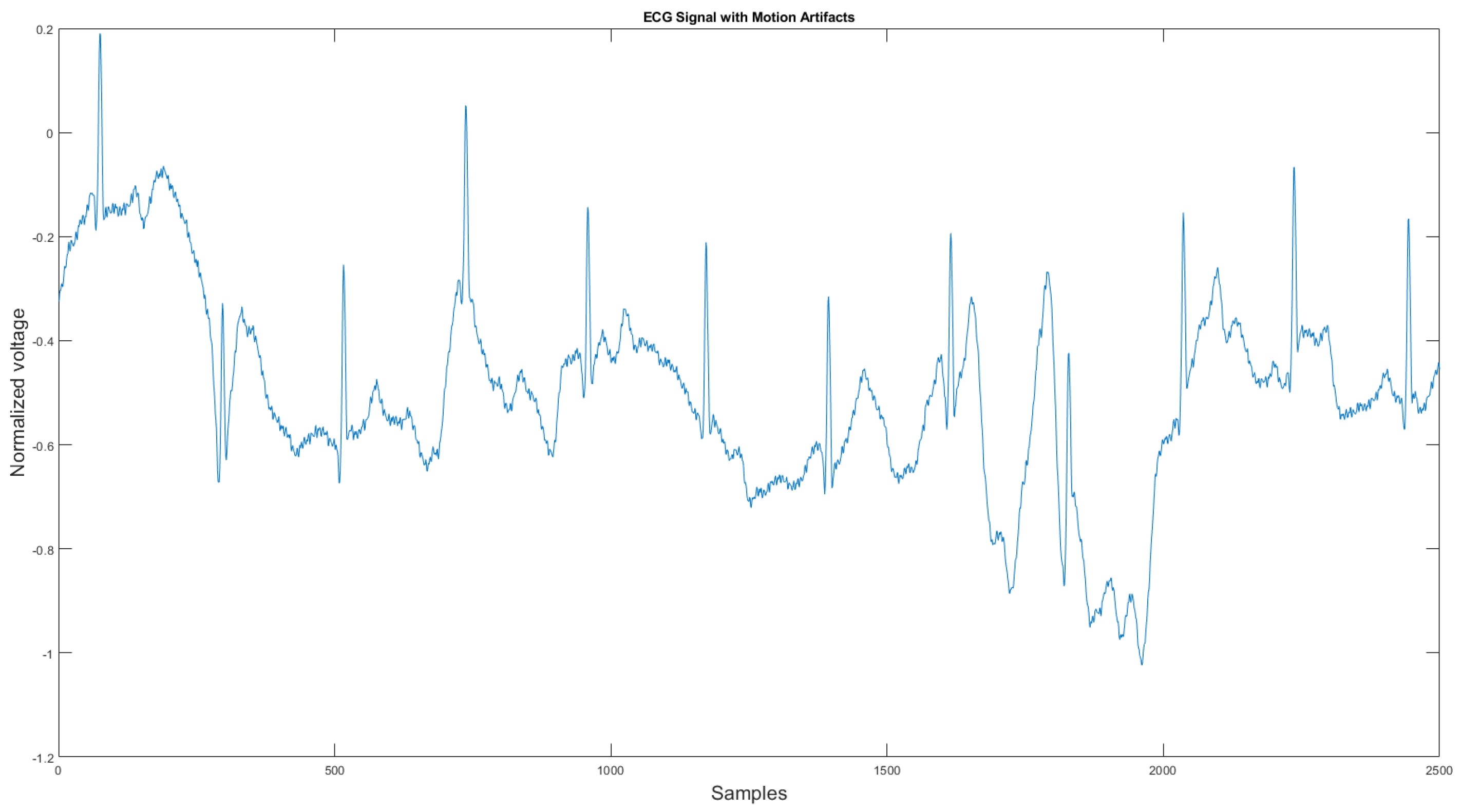






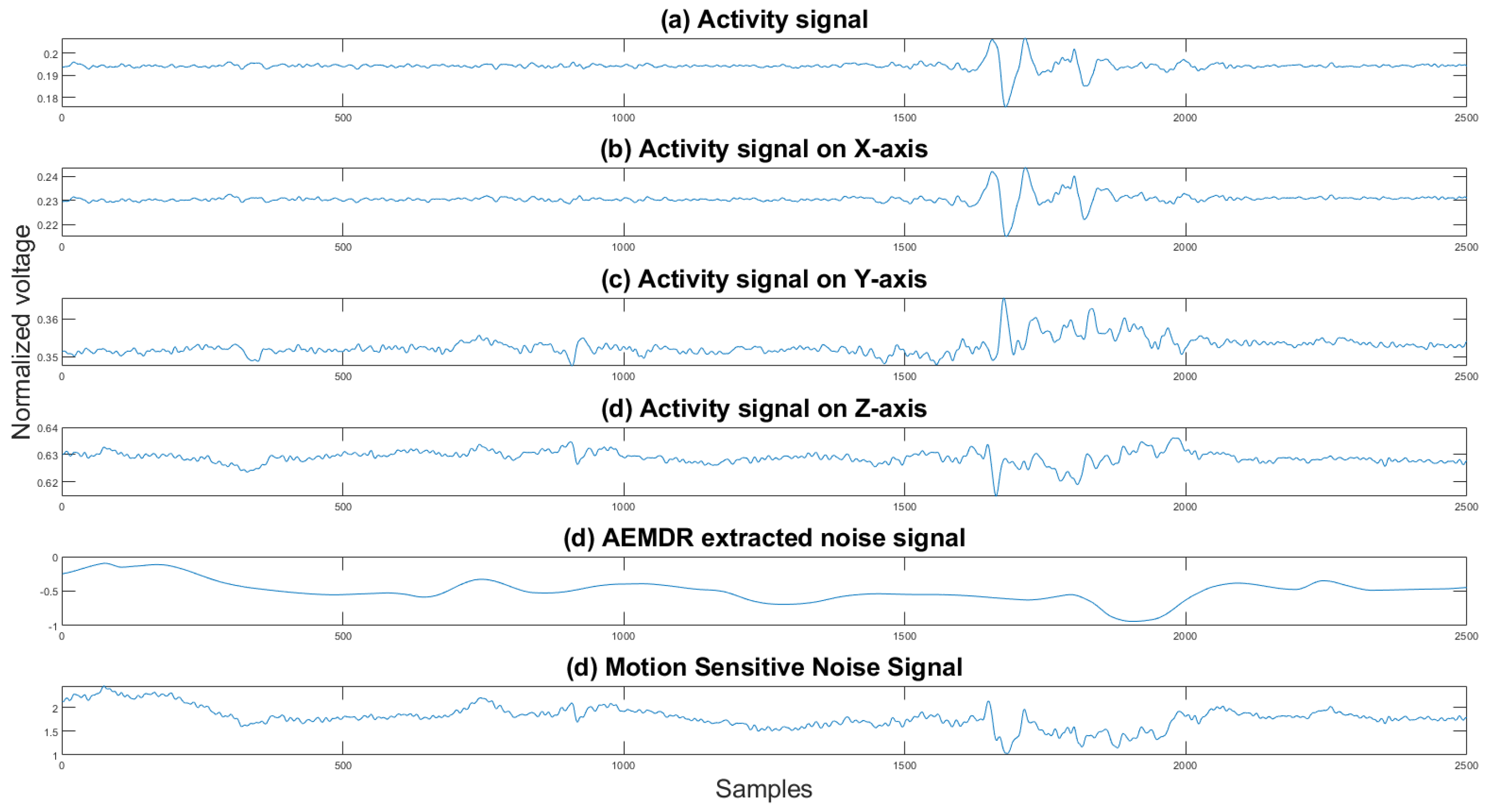
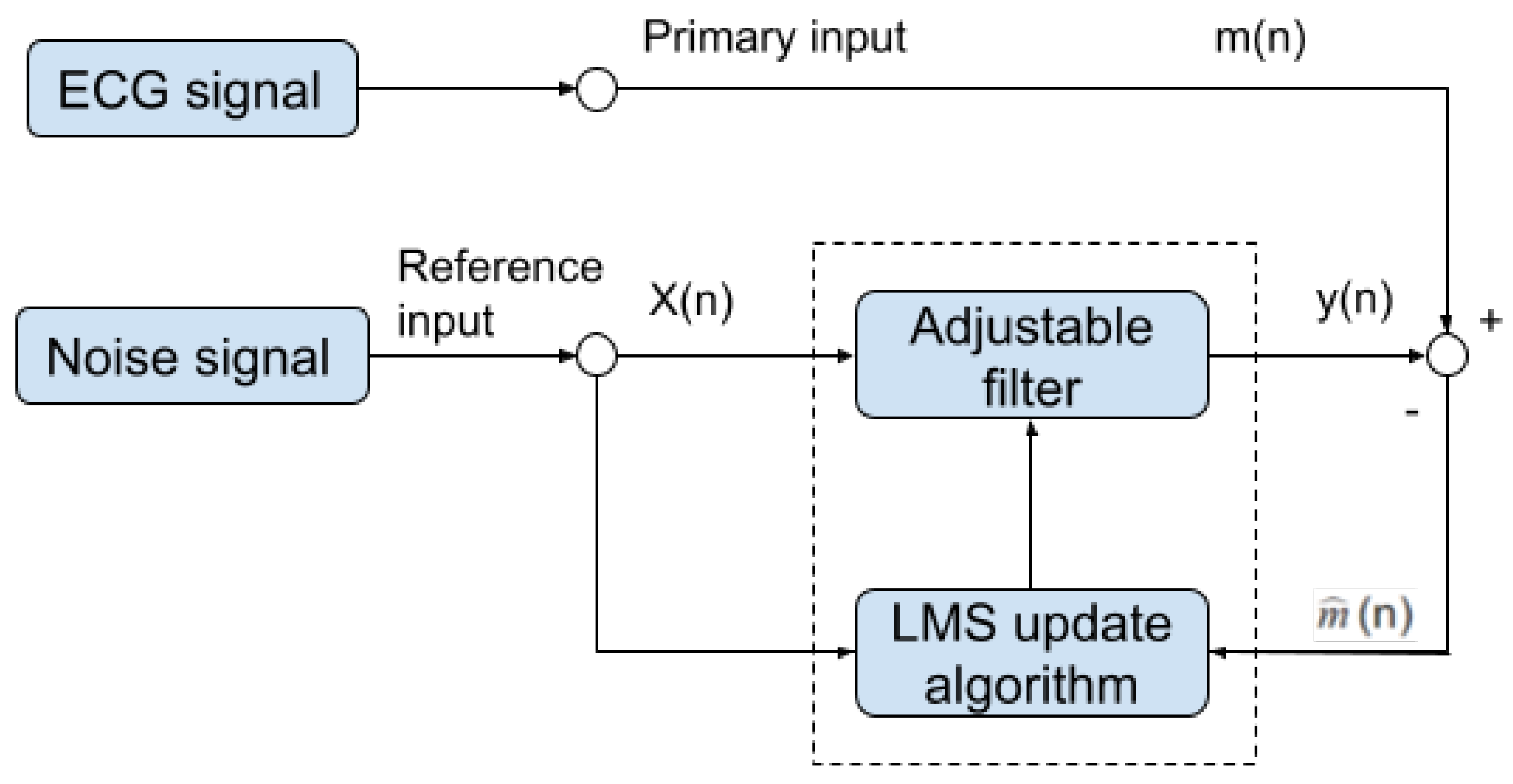

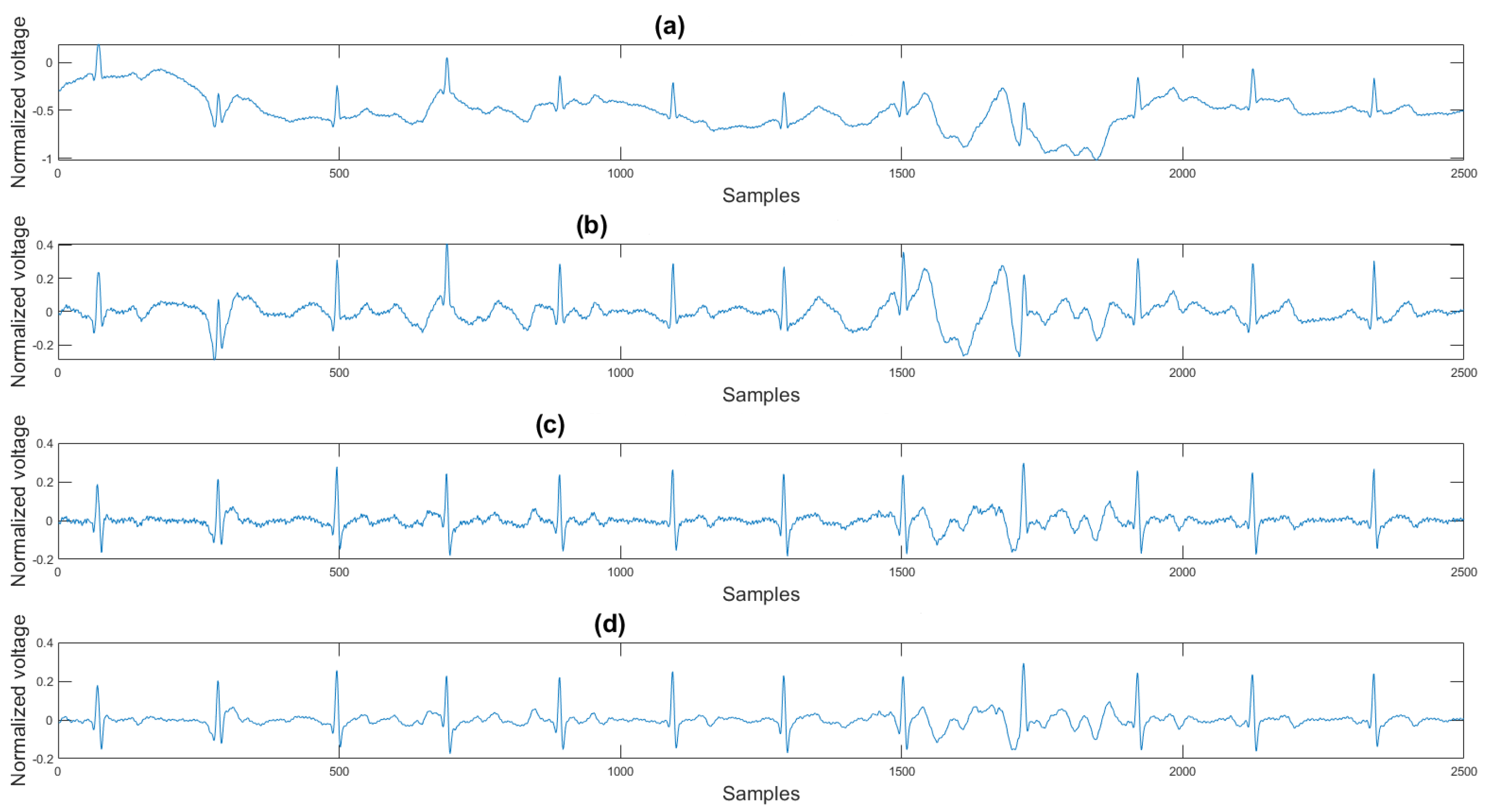

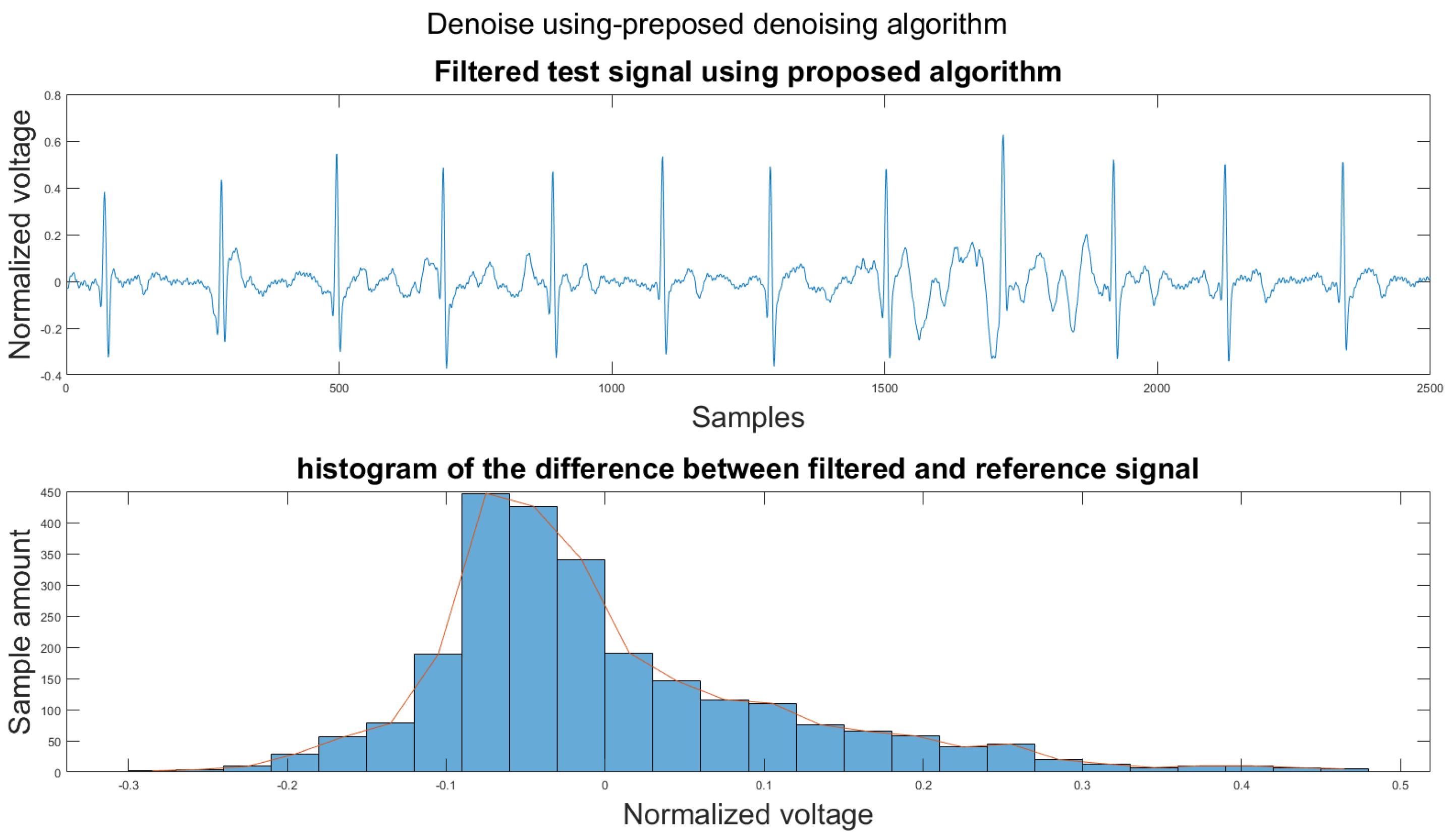
| TP | FP | TN | FN | SEN | SPC | ACC |
|---|---|---|---|---|---|---|
| 99 | 2 | 48 | 1 | 99% | 96% | 98% |
| Figure | Metric | Original | IIR | MA | DWT | EMD | VMD | AF | Proposed |
|---|---|---|---|---|---|---|---|---|---|
| Figure 14 and Figure A1, Figure A2, Figure A3, Figure A4, Figure A5, Figure A6 | CORR | −0.0337 | 0.2962 | 0.3169 | 0.3303 | 0.4540 | 0.4395 | 0.4594 | 0.5369 |
| Figure 14 and Figure A1, Figure A2, Figure A3, Figure A4, Figure A5, Figure A6 | MSE | 0.0419 | 0.0326 | 0.0307 | 0.1357 | 0.0090 | 0.0260 | 0.0086 | 0.0047 |
| Figure A7, Figure A8, Figure A9, Figure A10, Figure A11, Figure A12 and Figure A13 | CORR | 0.0651 | 0.3072 | 0.3442 | 0.2507 | 0.4981 | 0.4712 | 0.4988 | 0.5902 |
| Figure A7, Figure A8, Figure A9, Figure A10, Figure A11, Figure A12 and Figure A13 | MSE | 0.0163 | 0.0129 | 0.0123 | 0.3053 | 0.0066 | 0.0092 | 0.0065 | 0.0040 |
| Figure A14, Figure A15, Figure A16, Figure A17, Figure A18, Figure A19 and Figure A20 | CORR | 0.1316 | 0.1846 | 0.2186 | 0.1307 | 0.2719 | 0.3047 | 0.3660 | 0.4243 |
| Figure A14, Figure A15, Figure A16, Figure A17, Figure A18, Figure A19 and Figure A20 | MSE | 0.1091 | 0.0425 | 0.0369 | 0.1000 | 0.0412 | 0.0302 | 0.0092 | 0.0054 |
| Figure A22, Figure A23, Figure A24, Figure A25, Figure A26, Figure A27 and Figure A28 | CORR | 0.1557 | 0.3438 | 0.3181 | 0.1638 | 0.1881 | 0.3031 | 0.2929 | 0.4409 |
| Figure A22, Figure A23, Figure A24, Figure A25, Figure A26, Figure A27 and Figure A28 | MSE | 11.1281 | 1.3549 | 10.2285 | 8403 | 3.0299 | 0.9603 | 0.5916 | 0.1647 |
| Figure A29, Figure A30, Figure A31, Figure A 32, Figure A33, Figure A34 and Figure A35 | CORR | 0.2992 | 0.4227 | 0.4393 | 0.3129 | 0.4220 | 0.4759 | 0.4867 | 0.6011 |
| Figure A29, Figure A30, Figure A31, Figure A 32, Figure A33, Figure A34 and Figure A35 | MSE | 4.0803 | 0.7239 | 0.7073 | 3.7537 | 0.9917 | 0.3016 | 0.3188 | 0.1144 |
| Figure A36, Figure A37, Figure A38, Figure A39, Figure A40, Figure A41 and Figure A42 | CORR | 0.2875 | 0.4844 | 0.4523 | 0.051 | 0.3839 | 0.5292 | 0.4867 | 0.5242 |
| Figure A36, Figure A37, Figure A38, Figure A39, Figure A40, Figure A41 and Figure A42 | MSE | 5.8771 | 0.3676 | 0.4371 | 5.6547 | 0.3931 | 0.4822 | 0.3188 | 0.1304 |
Publisher’s Note: MDPI stays neutral with regard to jurisdictional claims in published maps and institutional affiliations. |
© 2021 by the authors. Licensee MDPI, Basel, Switzerland. This article is an open access article distributed under the terms and conditions of the Creative Commons Attribution (CC BY) license (https://creativecommons.org/licenses/by/4.0/).
Share and Cite
Li, H.; Boulanger, P. An Automatic Method to Reduce Baseline Wander and Motion Artifacts on Ambulatory Electrocardiogram Signals. Sensors 2021, 21, 8169. https://doi.org/10.3390/s21248169
Li H, Boulanger P. An Automatic Method to Reduce Baseline Wander and Motion Artifacts on Ambulatory Electrocardiogram Signals. Sensors. 2021; 21(24):8169. https://doi.org/10.3390/s21248169
Chicago/Turabian StyleLi, Hongzu, and Pierre Boulanger. 2021. "An Automatic Method to Reduce Baseline Wander and Motion Artifacts on Ambulatory Electrocardiogram Signals" Sensors 21, no. 24: 8169. https://doi.org/10.3390/s21248169
APA StyleLi, H., & Boulanger, P. (2021). An Automatic Method to Reduce Baseline Wander and Motion Artifacts on Ambulatory Electrocardiogram Signals. Sensors, 21(24), 8169. https://doi.org/10.3390/s21248169







